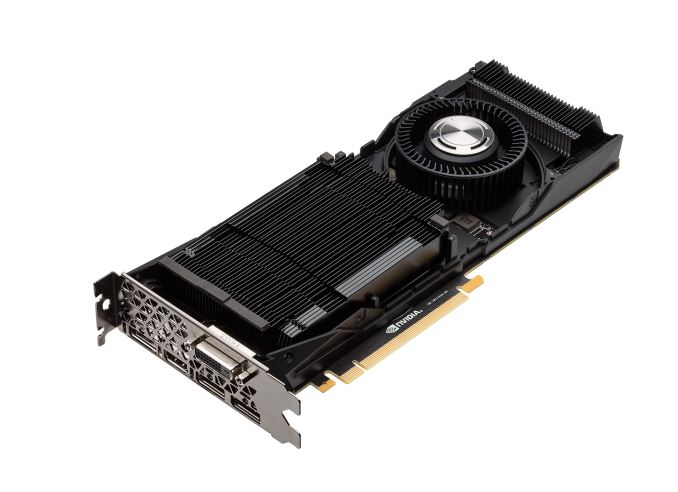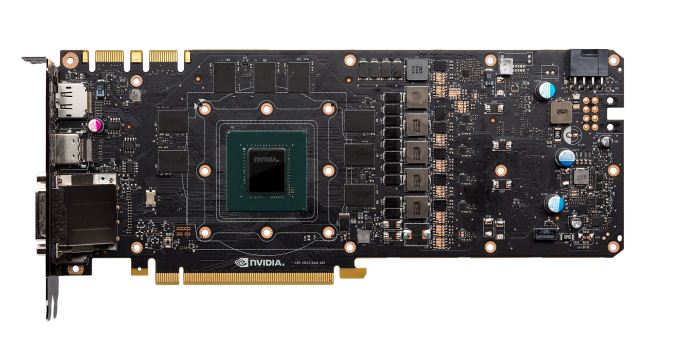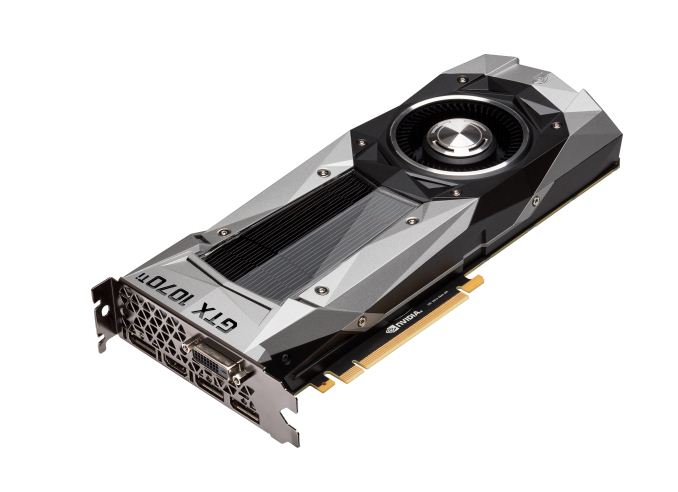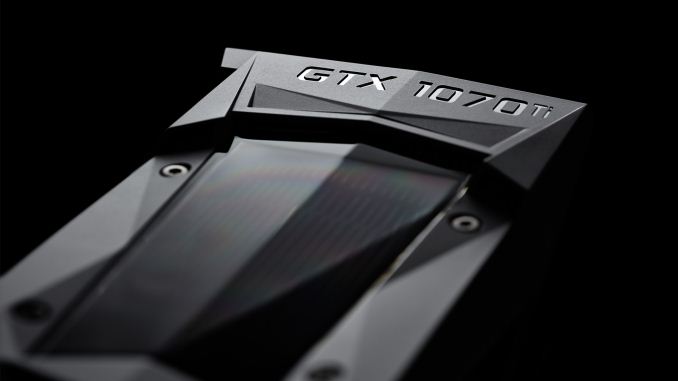
Original Link: https://www.anandtech.com/show/11987/the-nvidia-geforce-gtx-1070-ti-founders-edition-review
The NVIDIA GeForce GTX 1070 Ti Founders Edition Review: GP104 Comes in Threes
by Nate Oh on November 2, 2017 9:00 AM EST- Posted in
- GeForce
- GPUs
- NVIDIA
- Pascal
- GTX 1070 Ti
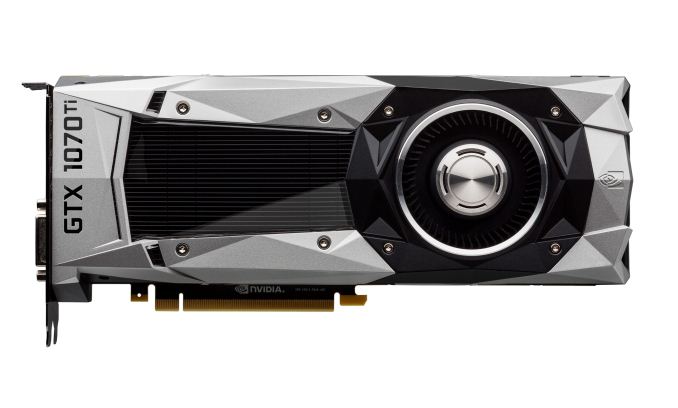
Earlier this March, our GeForce GTX 1080 Ti review opened by noting that 2016 was a banner year for NVIDIA, with their execution in multiple fields resulting in record revenue. We mentioned all this not only because of the capstone nature of the GeForce GTX 1080 Ti, but also in how the card positioned NVIDIA for the rest of the year, running up the score alongside the GeForce GTX 1080 and GeForce GTX 1070.
Since then, what has changed? From AMD, we’ve seen the April release of the Polaris-based Radeon RX 500 series, still aimed at the mainstream market. And then finally in August, after teasers, architectural overviews, and a Frontier Edition or two, AMD launched their high-end Radeon RX Vega 64 and 56 cards, roughly targeting the GTX 1080 and 1070 respectively. So only the last few months have seen the first challenge to NVIDIA’s 1-2-3 position this generation.
Launching today, then, is the GeForce GTX 1070 Ti, announced last week when it was first available for preorders.
| NVIDIA GPU Specification Comparison | |||||
| GTX 1080 | GTX 1070 Ti | GTX 1070 | |||
| CUDA Cores | 2560 | 2432 | 1920 | ||
| Texture Units | 160 | 152 | 120 | ||
| ROPs | 64 | 64 | 64 | ||
| Core Clock | 1607MHz | 1607MHz | 1506MHz | ||
| Boost Clock | 1733MHz | 1683MHz | 1683MHz | ||
| Memory Clock | 10Gbps GDDR5X | 8Gbps GDDR5 | 8Gbps GDDR5 | ||
| Memory Bus Width | 256-bit | 256-bit | 256-bit | ||
| VRAM | 8GB | 8GB | 8GB | ||
| FP64 | 1/32 | 1/32 | 1/32 | ||
| TDP | 180W | 180W | 150W | ||
| GPU | GP104 | GP104 | GP104 | ||
| Transistor Count | 7.2B | 7.2B | 7.2B | ||
| Manufacturing Process | TSMC 16nm | TSMC 16nm | TSMC 16nm | ||
| Launch Date | 05/27/2016 | 11/02/2017 | 06/10/2016 | ||
| Launch Price | MSRP: $599 Founders: $699 |
MSRP: $449 Founders: $449 |
MSRP: $379 Founders: $449 |
||
As the third GP104 based GTX 10 series card, the GTX 1070 Ti comes 16 months after the release of the GTX 1080 and 1070, falling between them in price and performance. The end result is a shoulder-to-shoulder three card stack, all based on a Gx104 GPU, something that NVIDIA rarely offers historically. As a later-cycle product, the card also conspicuously follows on the back of AMD’s reentry into the high-end graphics space with RX Vega, and in that vein NVIDIA is comparing the GTX 1070 Ti to the Vega 56 directly.
At the time of their Vega launch, AMD matched up the Vega 64 against the GTX 1080 and the Vega 56 against the GTX 1070. Although the GTX 1080 Ti continues to rule the roost, in August we saw the air-cooled reference Vega 64 trade blows with the GTX 1080, while the reference Vega 56 edged out the GTX 1070 by around 8%, albeit with greater power consumption. In aiming at the Vega 56, the GTX 1070 Ti is angling at reversing that performance advantage.
As for the GPU itself, described earlier at last week’s announcement, the GTX 1070 Ti has GP104 as a 19 SM arrangement, four more SMs than the GTX 1070. This is combined with the GTX 1080’s higher 180W TDP, the GTX 1070’s GDDR5 memory and bandwidth, and clockspeeds somewhere in between. While the GTX 1070 Ti’s additional SMs provide more shading, texturing and geometry resources than the GTX 1070, this is balanced out by the memory bandwidth and ROP throughput staying at the same level. Consequently, the GTX 1070 Ti is setup to fare better in compute-bound games thanks to the extra SMs, as opposed to bandwidth- or ROP-intensive games.
By the numbers, the GeForce GTX 1070 Ti offers 19% more shading/texturing/geometry throughput than the GeForce GTX 1070, paired with no change in ROP throughput or memory bandwidth. Or to compare things to the GTX 1080, the GTX 1070 Ti offers 92% of the GTX 1080's shader/texture/geometry throughput, 97% of the ROP performance, and 80% of the memory bandwidth. For performance then, going by NVIDIA’s numbers, the GTX 1070 Ti is promoted as being around 15% faster than the GTX 1070 but 8% slower than the GTX 1080.
Whatever the real-world performance difference might be, the GTX 1070 Ti price is roughly in the middle between the GTX 1080 and 1070. NVIDIA’s Founders Edition is statically set at $449, but the official MSRP starts at that point, presumably going no higher than the low ceiling of $500 or so where GTX 1080 cards come into play. While it is notable that the GTX 1070 Ti Founders Edition doesn’t carry the traditional Founders Edition price premium, even a $50 premium would collide with $500 GTX 1080 models. And an MSRP at any lower price points would bump into the GTX 1070.
Given the narrow price and performance window that the GTX 1070 Ti is attempting to squeeze into, all GTX 1070 Ti boards are shipping with the same 1607MHz base/1683MHz boost reference clocks and overall, the number of SKUs will be more limited. The obvious consequence of factory overclocked GTX 1070 Ti’s is that those cards would overlap GTX 1080s on price and potentially performance, thus cannibalizing and competing with NVIDIA’s own products. Which begs the question as to why NVIDIA would force the issue in creating such a tightly-packed product lineup in the first place.
Looking at the pricing, performance, and positioning, it is clear that NVIDIA is shoring up their stack against any kind of AMD incursion. In particular, AMD was able to position the reference Vega 56 above the GTX 1070, but a GTX 1070 Ti now blocks that kind of encroachment with minimal collateral sales damage, provided that the card stays in between the GTX 1080 and 1070 in both price and performance.
In any case, NVIDIA is still pushing the card as a good overclocking card, but without factory overclocks, leaving it to the consumers to overclock with the usual third-party utilities. Thereby, they can avoid factory overclocked designs that could outright undermine the GTX 1080, but still market the overclockability. Incidentally, by having to stick so closely in the $449 - $500 range, AIB partners may not have the margins to offer over-engineered and costlier custom designs that would attract overclockers. And given the tightness of the price bracket, it may not be economical to test and validate truly high-clocking boards, only to sell them at significantly reduced margins. While some partner cards are advertising higher boosts via first-party utilities, or in the case of Zotac, "Factory Tested OC," at the moment it is unclear what those exactly mean. As a counterpoint, because the GTX 1070 Ti is utilizing GP104 and at the GTX 1080's TDP of 180W, partners can and are reusing their existing GTX 1080 designs, much like NVIDIA has done with their reference GTX 1070 Ti Founders Edition, as we will soon find out.
Another factor that Ryan brought up last week was chip yields of the GPU itself. After 16 months of yield improvement at TSMC, GP104 GPUs fabbed on the mature 16nm FF process may not have as many defective SMs as they used to. After all, NVIDIA and TSMC were able to fab the gargantuan 815mm2 GV100 with high enough yields to be commercially viable. And GP104 happens to be a GPU that pops up in a number of places outside desktop GeForce graphics cards, including notebooks, Quadros, and even in mining cards as P104s.
And on that note, cryptocurrency mining demand has drastically affected graphics card supply and demand this year, actually leading to the creation of mining-specific cards. Even NVIDIA’s cards, which typically are less efficient or performant at cryptomining than AMD’s, have gone through shortages this year. Cryptomining continues to have an impact on prices and availability. But where the GTX 1070 Ti stands for miners is a bit of an open question; the GTX 1080 continues to be hampered by its GDDR5X memory as it cannot be fully utilized by Ethereum, but the GTX 1070 Ti does not offer memory bandwidth improvements over the GTX 1070.
Ultimately, the starting MSRP is $449, where the Founders Edition is priced at, and a number of custom cards are available today from partners. Looking at the prices, $449 is unsurprisingly where partner blower cards fall. While only a few GTX 1070 Ti's touch the $499 mark, this puts it very close to custom design GTX 1080s; at the time of this writing, the MSI GeForce GTX 1080 Armor 8G and Duke 8G are priced at $509, excluding the Armor 8G's current $10 rebate that brings it down to $499. At the same price of a custom cooled GTX 1070 Ti, consumers may also buy custom cooled GTX 1080s. So custom GTX 1080s do drift down here, and partner GTX 1080 blowers are commonly found in the low $500s as well. As for high-end GTX 1070s, EVGA GeForce GTX 1070 FTW Hybrid and standard Hybrid are both at $500, with liquid cooler and fan hybrid cooling system.
| Selected Partner GeForce GTX 1070 Ti Launch Cards | |||
| Card | Advertised Boost | Launch Price | |
| NVIDIA GTX 1070 Ti Founders Edition | 1683MHz | $449 | |
| ASUS GTX 1070 Ti Turbo (Blower) | 1683MHz | $449 | |
| ASUS GTX 1070 Ti ROG Strix 8G | 1721MHz (GPU Tweak) |
$499 | |
| ASUS GTX 1070 Ti ROG Strix Advanced Edition (A8G) | 1759MHz (GPU Tweak) |
$499 | |
| EVGA GTX 1070 Ti Gaming (Blower) | 1683+MHz | $449 | |
| EVGA GTX 1070 Ti FTW2 | 1683+MHz | $499 | |
| EVGA GTX 1070 Ti SC Black | 1683+MHz | $469 | |
| EVGA GTX 1070 Ti Hybrid | 1683+MHz | $529 | |
| GIGABYTE GTX 1070 Ti Gaming 8G | 1733MHz (AORUS Engine) |
$489 | |
| MSI GTX 1070 Ti Aero (Blower) | 1683MHz | $449 | |
| MSI GTX 1070 Ti Duke 8G | 1683MHz | $469 | |
| MSI GTX 1070 Ti Gaming 8G | 1683MHz | $489 | |
| MSI GTX 1070 Ti Titanium 8G | 1683MHz | $489 | |
| Zotac GTX 1070 Ti AMP! | Factory Tested OC: 1753MHz GPU, 2102MHz Memory |
$469 | |
| Zotac GTX 1070 Ti AMP! Extreme | Factory Tested OC: 1833MHz GPU, 2202MHz Memory |
$499 | |
| Zotac GTX 1070 Ti Mini | 1683MHz | $449 | |
As for the competitive landscape, the GTX 1070 Ti is squaring off with Vega 56. Aside from price and availability, the GTX 1070 Ti has the advantage of launching with custom partner cards, whereas partner RX Vega cards have yet to hit the market. RX Vega 56 is currently only available with a reference blower, which may not be an ideal matchup against custom designs. But for today, we are looking at the GTX 1070 Ti Founders Edition, pitching reference card against reference card.
| Fall 2017 GPU Pricing Comparison (Still Crypto-Crazy Edition) | |||||
| AMD | Price | NVIDIA | |||
| Radeon RX Vega 64 | $509 | GeForce GTX 1080 | |||
| $449 | GeForce GTX 1070 Ti | ||||
| Radeon RX Vega 56 | $399/$409 | GeForce GTX 1070 | |||
| Radeon RX 580 (8GB) | $289 | ||||
| $259 | GeForce GTX 1060 (6GB) | ||||
Meet the GeForce GTX 1070 Ti Founders Edition
For the GeForce GTX 1070 Ti Founders Edition, pinned at the official MSRP of $449, NVIDIA has essentially plopped the GTX 1070 Ti GPU into a GTX 1080 board. This makes a lot of sense considering that this late-cycle card has the same GPU and 180W TDP requirements of NVIDIA's GeForce GTX 1080. Doing so allows NVIDIA to drop in the new specification and go with minimal changes, and similarly, their partners can take their own GTX 1080 designs and quickly reconfigure them for the GTX 1070 Ti.
The end result of this decision is that the GTX 1070 Founders Edition has the same power delivery and cooling specificaitons as the GTX 1080. Which is to say that it retains the same vapor chamber + blower cooling design, and the same 5+1 dual-FET power design. Similarly, that means the GTX 1070 Ti also has the same 120% power limit, and so extending the TDP to 216W. Otherwise, the PCB is exactly the same as the GTX 1080.
It is notable that the GTX 1070 Ti Founders Edition gets the vapor chamber cooler, as the card does not carry a price premium like the other Founders Edition cards do; NVIDIA is not charging more than their partners here. As a high efficiency cooling solution, the vapor chamber works well with the GTX 1070 Ti's increased (relative to the GTX 1070's) 180W TDP and 120% power limit. And while the blower fan is not the quietest, the Founders Edition is able to boost well past its paper-specified clockspeeds.
As we weren't provided with the GTX 1070 Ti PCB photos, we are using the GTX 1080 PCB with GDDR5X modules as an example. As with previous NVIDIA reference PCBs, the 5 GPU power phase and 1 GDDR5 phase is fine for stock operation and mild overclocking, rather than catering to the needs of hardcore overclockers. While not a major point, the Founders Edition isn't really apt to be pushed as a real "overclocking" card; it will boost a little higher but the user experience won't be significantly affected.
Finally, given the identical-to-1080 board design, the rest of the specifications should not come as a surprise. The 10.5" card requires a single PCIe 8-pin power connector for additional power, which combined with the 75W of the PCIe slot, gives the complete card more than enough power for its 180W TDP. Meanwhile on the display side of matters, the GTX 1070 Ti has 3x DisplayPort 1.4, an HDMI 2.0b port, and 1 DL-DVI-D port. The GTX 1070 Ti does support SLI, like all Pascal cards from the GTX 1070 and up.
The Test
To preface with relevant news, NVIDIA released driver version 388.13 WHQL earlier this week, bringing official support for the GTX 1070 Ti ahead of its release today. In addition, 388.13 brought game ready drivers for Call of Duty: WWII, Wolfenstein II: The New Colossus, and Need for Speed Payback. For resolved issues, NVIDIA has addressed second monitor blanking, yellow exclamation notices for graphics in Device Manager, and a corner case involving gamestreaming on hybrid notebooks. More details can be found in the 388.13 release notes. 388.13 is available for download on NVIDIA's driver download page.
For our review of the GTX 1070 Founders Edition, we are using NVIDIA's 388.09 driver supplied to us. The 2017 benchmark suite remains almost identical to the one described in the RX Vega review; inconsistent 1080p results for Dawn of War III were resolved and redone, while the Total War: Warhammer results from now onwards reflect the updated built-in benchmark, as Creative Assembly had changed the benchmark in late August.
As always, we try to use the best performing API for a particular graphics card.
| CPU: | Intel Core i7-7820X @ 4.3GHz |
| Motherboard: | Gigabyte X299 AORUS Gaming 7 (BIOS version F7) |
| Power Supply: | Corsair AX860i |
| Hard Disk: | OCZ Toshiba RD400 (1TB) |
| Memory: | G.Skill TridentZ DDR4-3200 4 x 8GB (16-18-18-38) |
| Case: | NZXT Phantom 630 Windowed Edition |
| Monitor: | LG 27UD68P-B |
| Video Cards: | AMD Radeon RX Vega 64 (Air Cooled) AMD Radeon RX Vega 56 AMD Radeon RX 580 AMD Radeon R9 Fury X NVIDIA GeForce GTX 1080 Ti Founders Edition NVIDIA GeForce GTX 1080 Founders Edition NVIDIA GeForce GTX 1070 Ti Founders Edition NVIDIA GeForce GTX 1070 Founders Edition |
| Video Drivers: | NVIDIA Release 388.09 (Press) AMD Radeon Software Crimson ReLive Edition 17.10.3 |
| OS: | Windows 10 Pro (Creators Update) |
Battlefield 1 (DX11)
Battlefield 1 leads off the 2017 benchmark suite with a bang as DICE brought gamers the long-awaited AAA World War 1 shooter a little over a year ago. With detailed maps, environmental effects, and pacy combat, Battlefield 1 provides a generally well-optimized yet demanding graphics workload. In light of DX12-related performance issues in this title, DX11 is utilized for all cards.
The Ultra preset is used with no alterations. As these benchmarks are from single player mode, our rule of thumb with multiplayer performance still applies: multiplayer framerates generally dip to half our single player framerates.
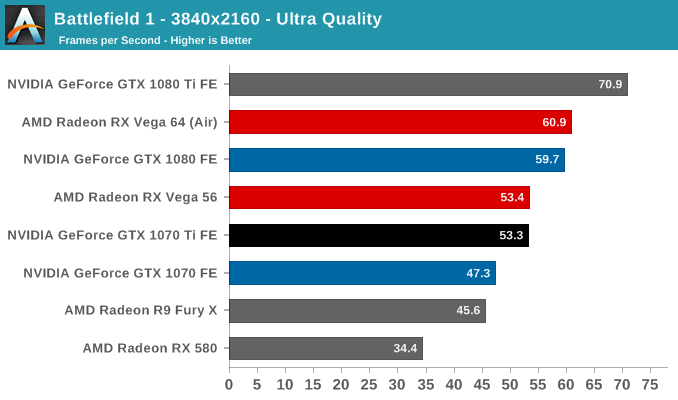
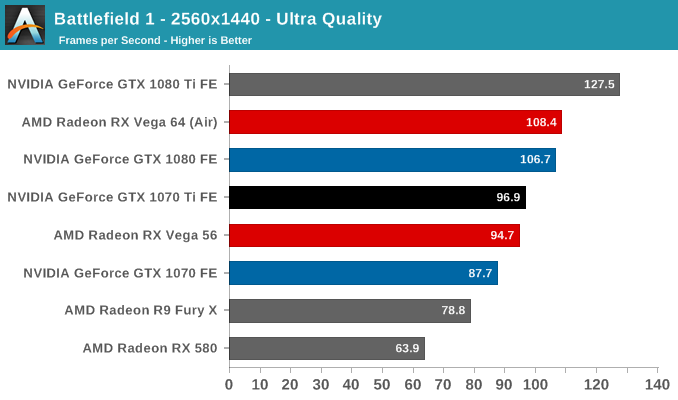
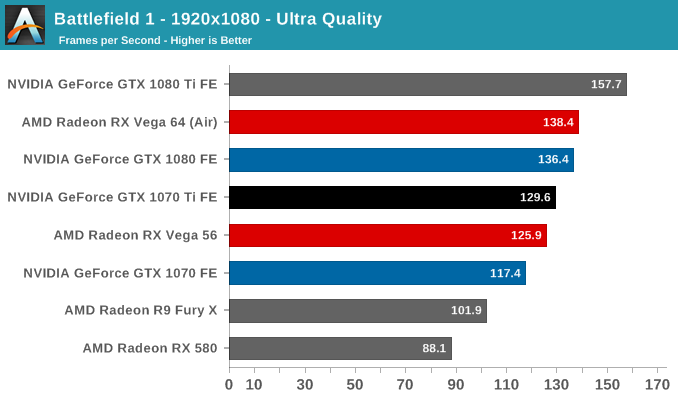
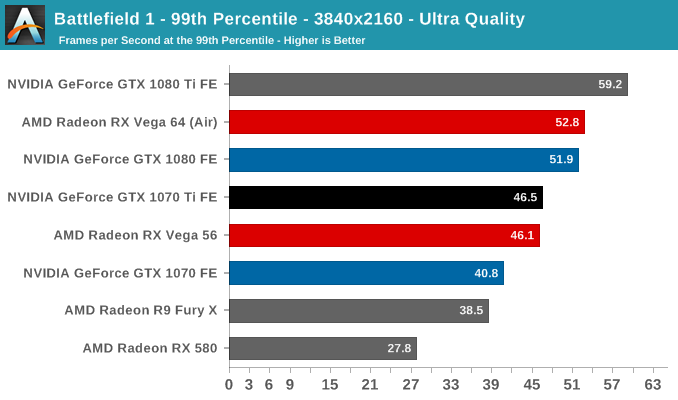
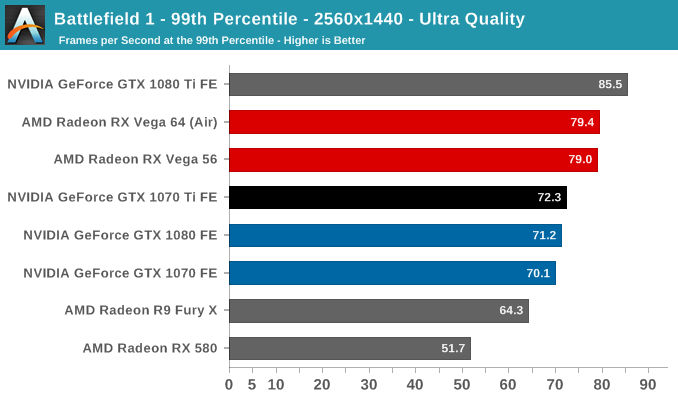
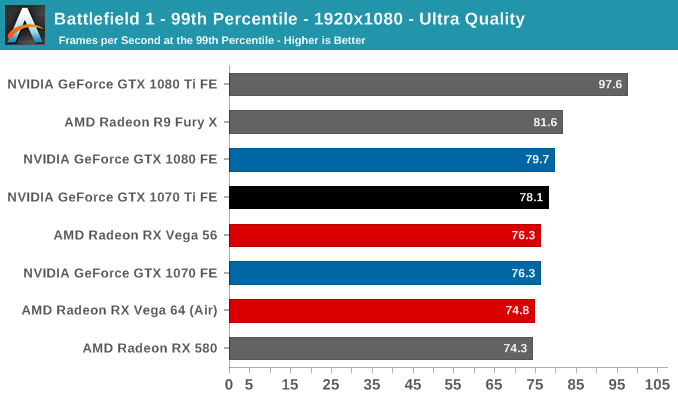
Battlefield 1 has shown itself to be rather favorable on Vega hardware, and against Vega 56 at 4K, the GTX 1070 Ti FE can only manage a draw. At lower resolutions, the Vega 56 loses its advantage, but the difference is slim.
Ashes of the Singularity: Escalation (DX12)
A veteran from our 2016 game list, Ashes of the Singularity: Escalation continues to be the DirectX 12 trailblazer, with developer Oxide Games tailoring and designing the Nitrous Engine around such low-level APIs. Ashes remains fresh for us in many ways: Escalation was released as a standalone expansion in November 2016 and was eventually merged into the base game in February 2017, while August 2017's v2.4 brought Vulkan support. Of all of the games in our benchmark suite, this is the game making the best use of DirectX 12’s various features, from asynchronous compute to multi-threaded work submission and high batch counts. While what we see can’t be extrapolated to all DirectX 12 games, it gives us a very interesting look at what we might expect in the future.
Settings and methodology remain identical from its usage in the 2016 GPU suite. To note, the latest version of Ashes has changed the Extreme graphical preset, dialing down MSAA from x4 to x2, as well as adjusting Texture Rank (MipsToRemove in settings.ini).
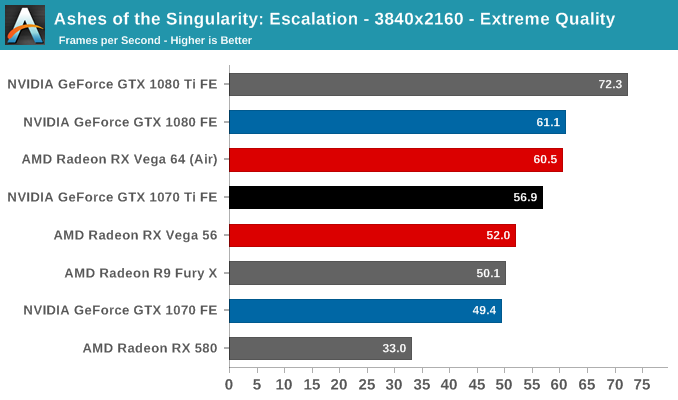
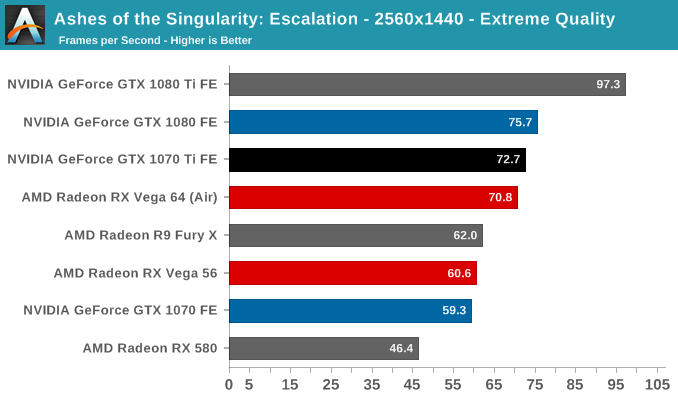
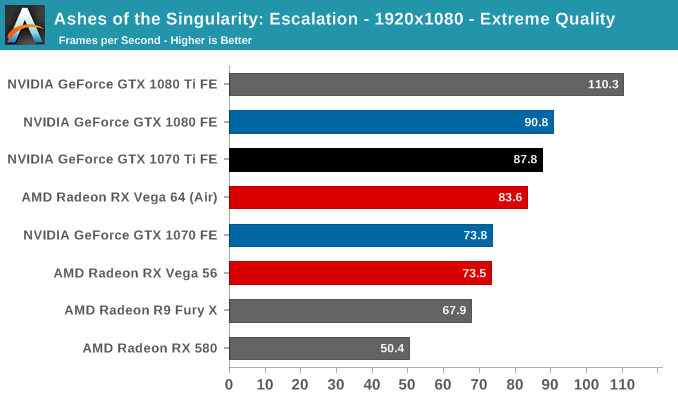
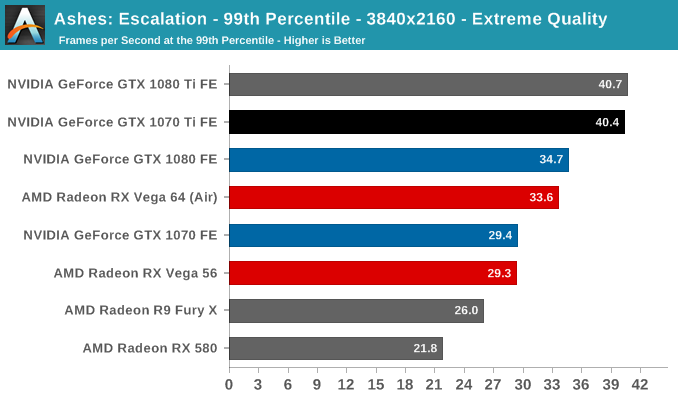
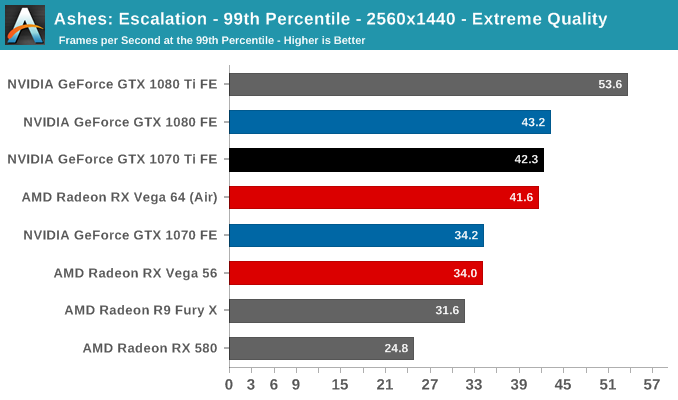
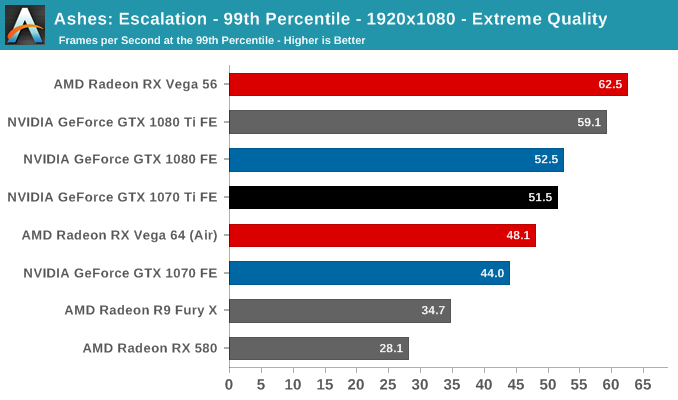
Here, the GTX 1070 Ti cleanly beats Vega 56, and even surpasses Vega 64 at sub-4K resolutions. While normally an AMD hardware favoring game, driver improvements over the past few months seem to have given the lead over to NVIDIA.
DOOM (Vulkan)
By now, we all know the legacy of the original 1993 DOOM, and 2016 DOOM seeks to fulfill its birthright of shooting things until they die. The fast-paced arena-shooter-style gameplay relies heavily on high framerates for an optimal experience as you twist and turn to eviscerate demons. Notably, thanks to a post-release update, DOOM supports the low-level Vulkan API, successor to AMD's Mantle and comparable to DX12 and Metal. One of the higher profile Vulkan games out there, DOOM could be considered a flagship Vulkan game, using the API successfully to achieve greater performance than what could be accomplished in OpenGL.
The Ultra preset was used without alterations.
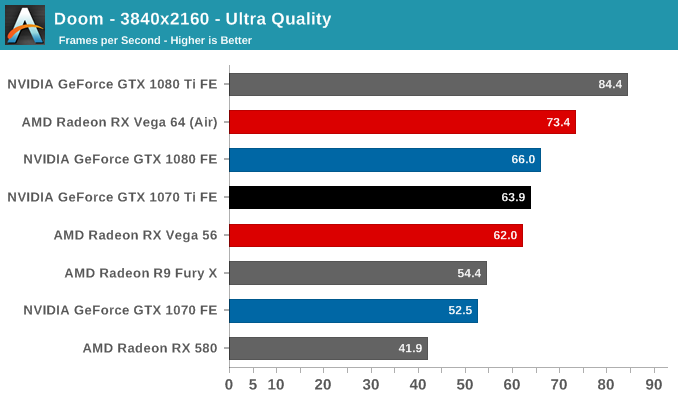
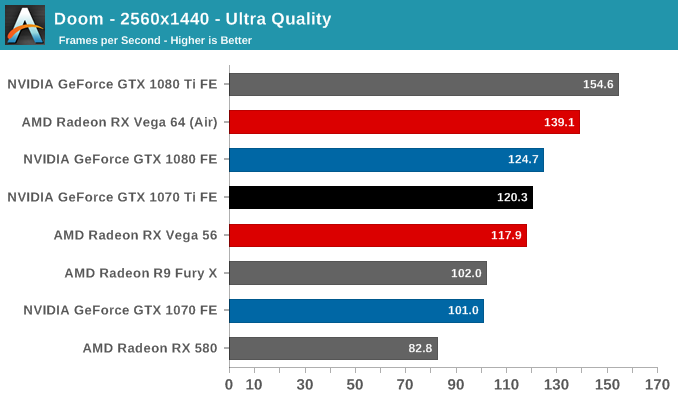
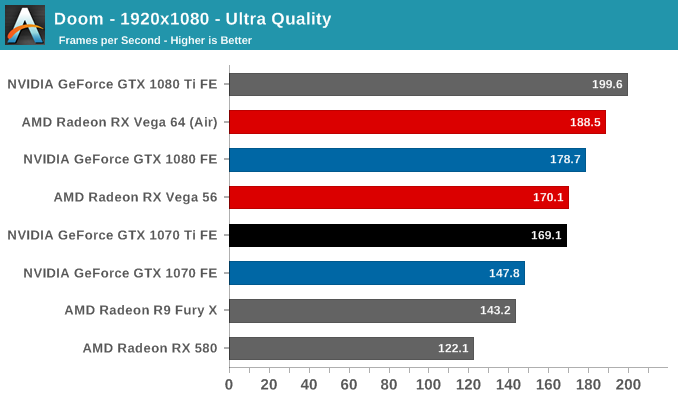
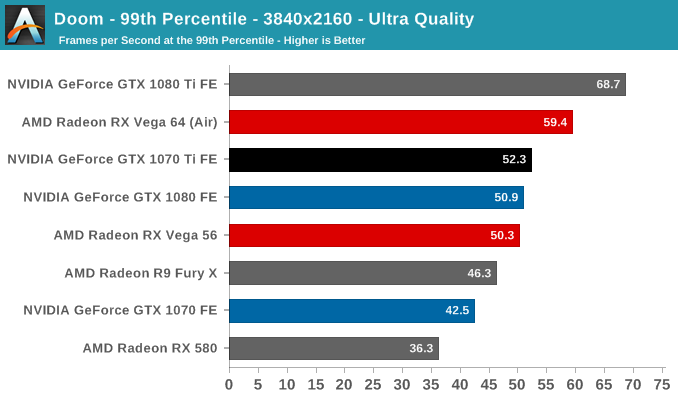
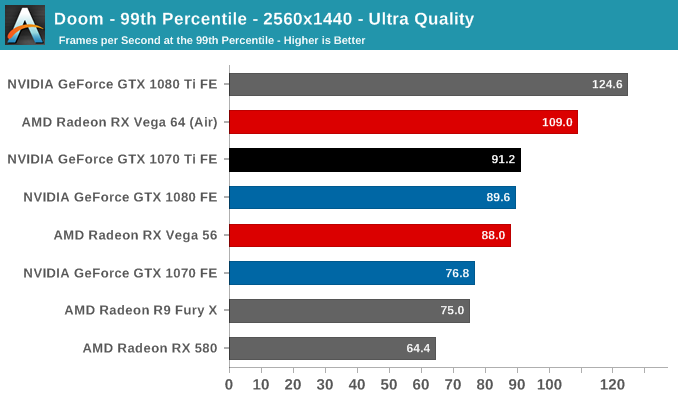
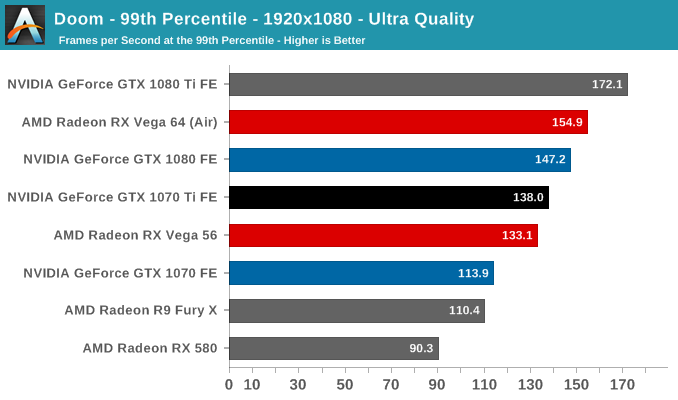
Operating well under Vulkan, both Vega 56 and GTX 1070 Ti come neck and neck, with the GTX 1070 Ti maintaining the edge at higher resolutions. DOOM actually has a 200fps cap, and the GTX 1080 Ti nearly tops out at 1080p.
Ghost Recon Wildlands (DX11)
Tom Clancy's Ghost Recon Wildlands brings a modern, highly demanding DX11 title to our suite, with the lush open world style FPS/3PS requiring heavy graphics horsepower to run at the highest settings. On that note, we turned down settings to Very High, which also had the effect of turning off NVIDIA GameWorks settings: HBAO+, Enhanced Volumetric Lighting (Godrays), and Turf Effects. This keeps performance apples-to-apples, and makes direct cross-vendor comparisons easier to make.
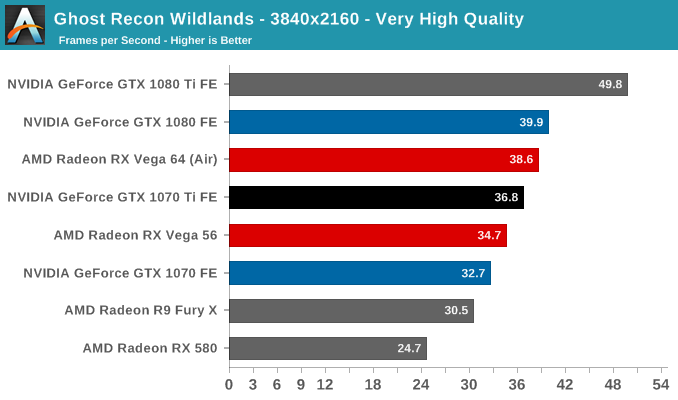
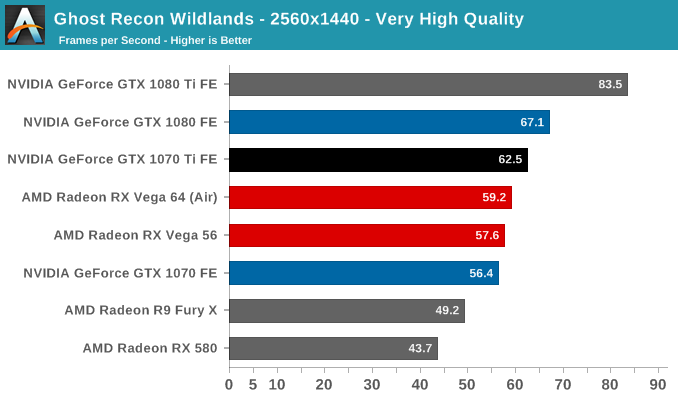
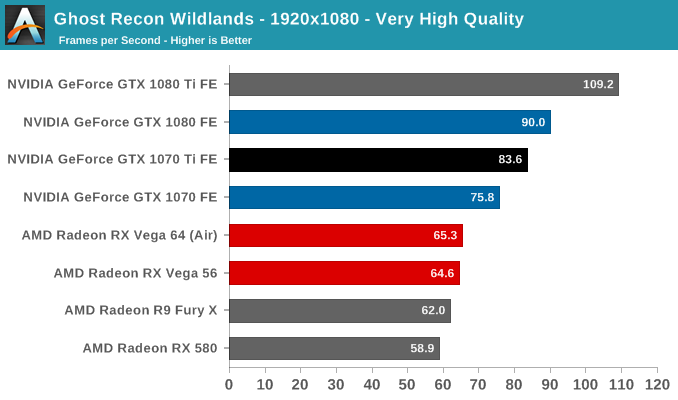
NVIDIA traditionally holds the advantage in Ghost Recon Wildlands, and this continues to play out here. At 4K, the GTX 1070 Ti splits Vega 56 and 64 as intended, and surpasses them as the RX Vega cards loses their high resolution edge.
Dawn of War III (DX11)
After more than 8 years, a Dawn of War game finally returns to our benchmark suite, adding a pure DX11 RTS to our lineup. With Dawn of War III, Relic offers a demanding RTS with a built-in benchmark; while we used the benchmark scene for consistency, we used OCAT to collect the performance data instead. Ultra settings were used without alterations.
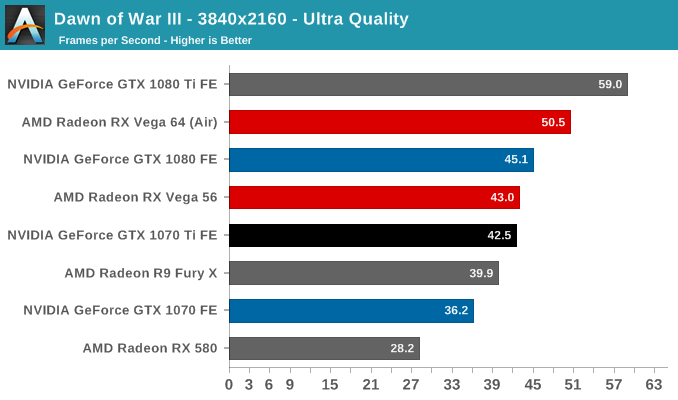
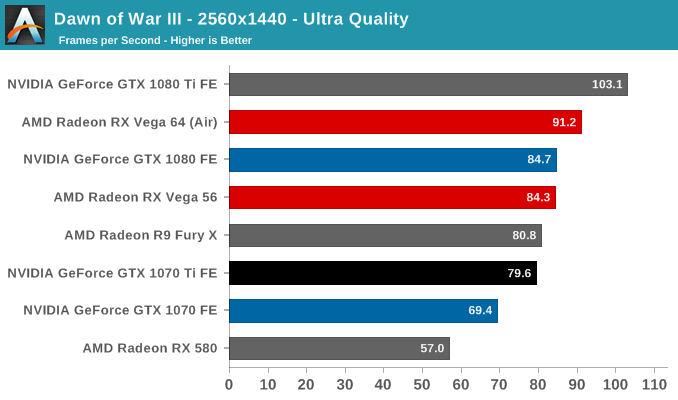
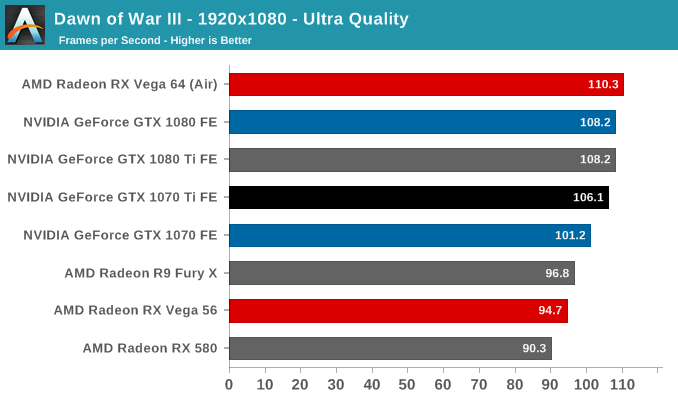
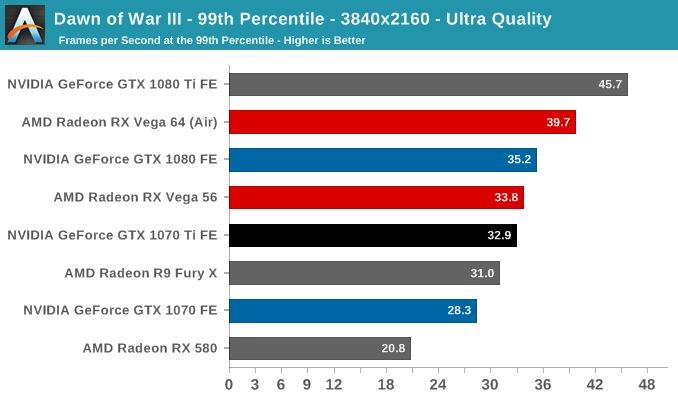
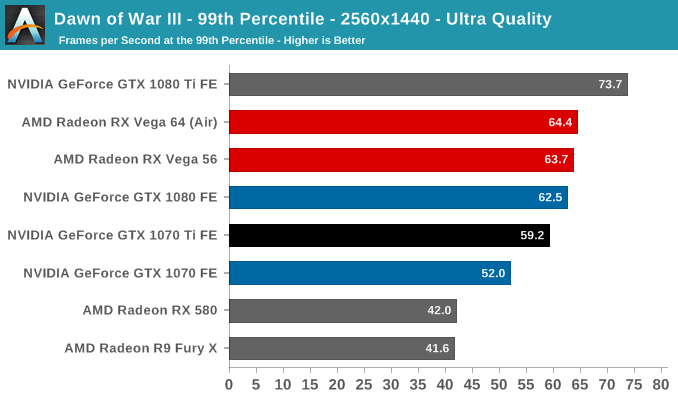
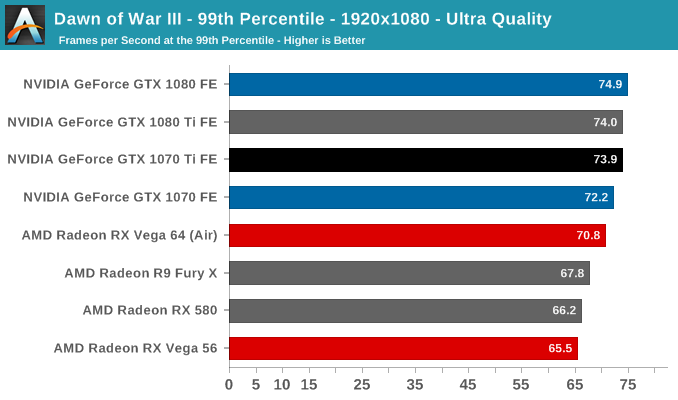
The GTX 1070 Ti loses out to Vega 56 at higher resolutions, but overtakes at the more CPU-bound 1080p. Despite being unable to match the Vega 56 at 2K and 4K, it does improve on the GTX 1070 FE.
Deus Ex: Mankind Divided
The latest entry to the Deus Ex series, Mankind Divided is a multi-genre, graphically-demanding DX11 title that received DX12 support a month after launch. Running through the built-in benchmark, we used Ultra settings without alterations.
After testing Vega cards under DX12, we noticed a consistent performance uplift, and switched over to that API for RX Vega 64 and 56. Unfortunately, this was not the case for the GTX 1070 Ti Founders Edition.
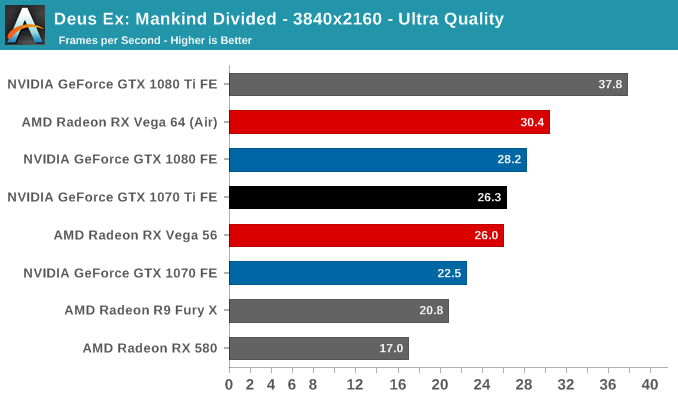
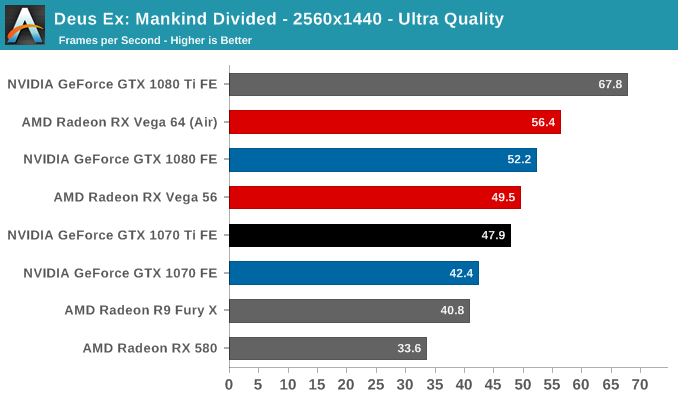
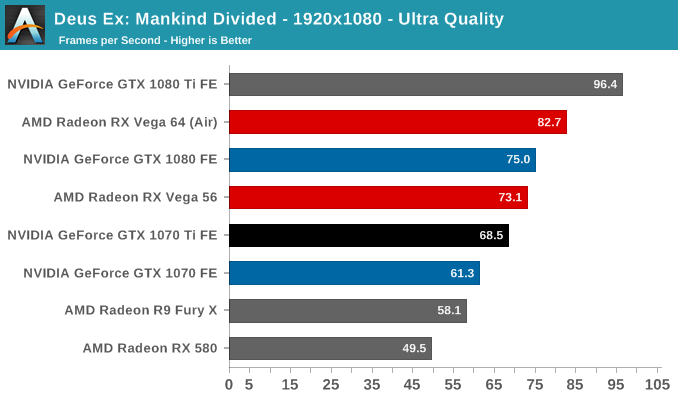
With the DX12 performance boost on RX Vega hardware, both Vega cards actually pull ahead from the GTX 1070 Ti at lower resolutions.
Grand Theft Auto V (DX11)
The other veteran from our 2016 GPU game suite, GTA V is still graphically demanding as they come. As an older DX11 title, it provides a glimpse into the graphically intensive games of yesteryear. Originally released for consoles in 2013, the PC port came with a slew of graphical enhancements and options. Just as importantly, GTA V includes a rather intensive and informative built-in benchmark, somewhat uncommon in open-world games.
Like its previous appearances, we follow those settings, as GTA V does not have presets. To recap, for "Very High" quality we have all of the primary graphics settings turned up to their highest setting, with the exception of grass, which is at its own very high setting. Meanwhile 4x MSAA is enabled for direct views and reflections. This setting also involves turning on some of the advanced rendering features - the game's long shadows, high resolution shadows, and high definition flight streaming - but not increasing the view distance any further.
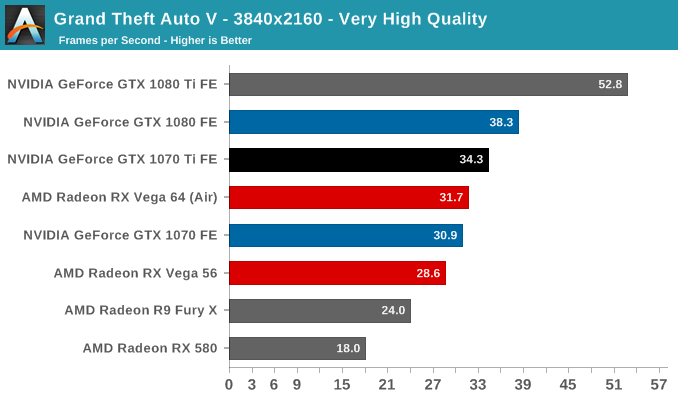
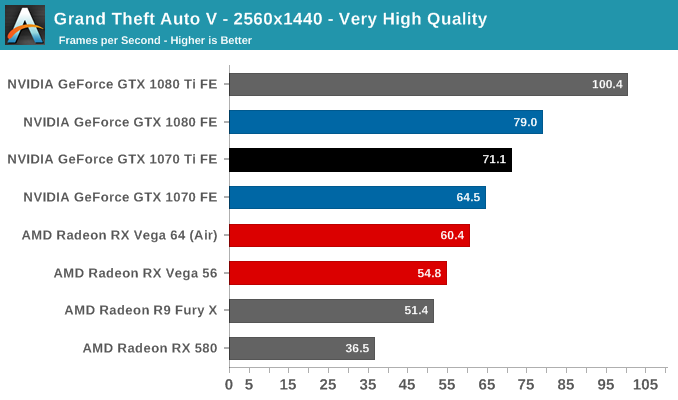
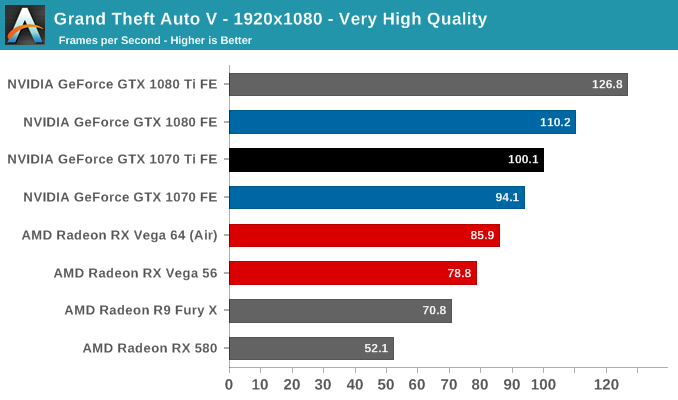
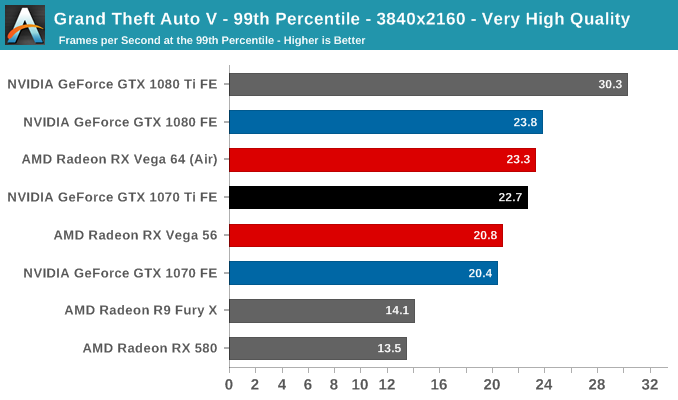
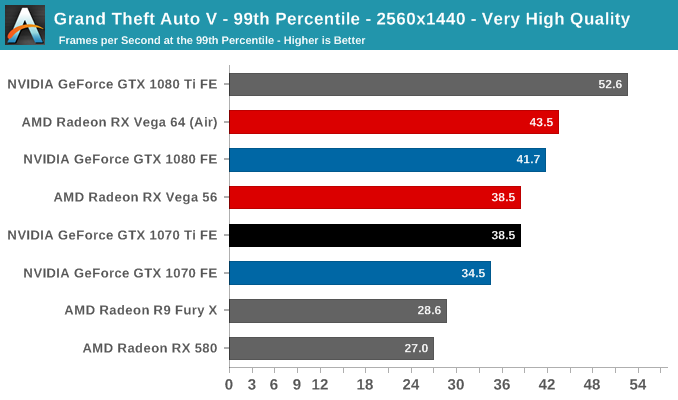
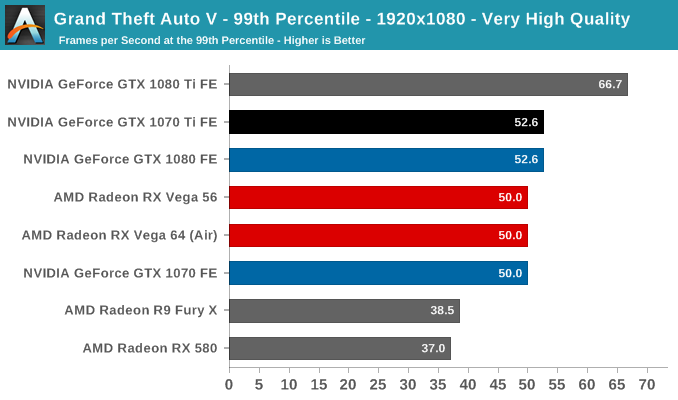
NVIDIA returns to dominance in GTAV, where AMD cards have typically struggled. Even at 4K, the GTX 1070 Ti tops Vega 64.
F1 2016 (DX11)
The spiritual successor to the 2016 suite's DiRT Rally, F1 2016 is Codemasters' latest installment of the F1 franchise. It features Codemasters' traditional built-in benchmarking tools and scripts, something that is surprisingly absent in the latest iteration of DiRT. Graphically demanding in its own right, F1 2016 adds a useful racing-type graphics workload to our benchmarks.
Ultra settings were used without alterations.
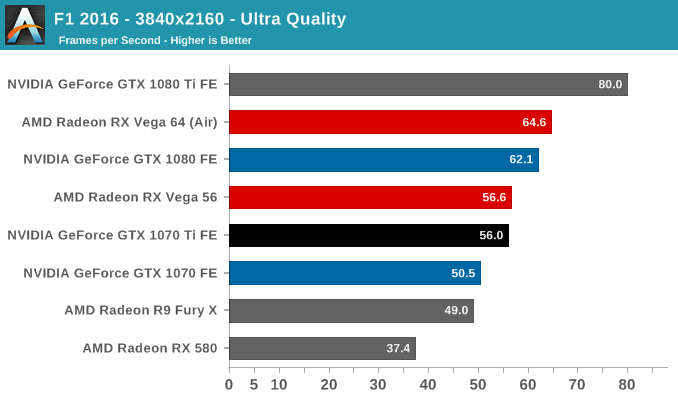
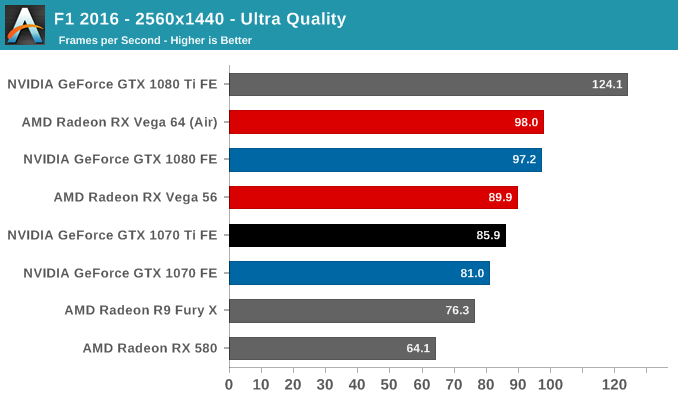
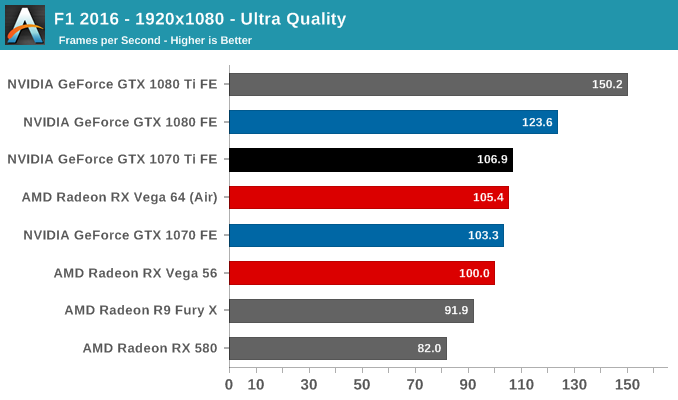
F1 2016 continues the trend of RX Vega cards losing luster as resolution decreases, a trait also seen in Fiji and Hawaii.
Total War: Warhammer (DX11 & DX12)
The last game in our lineup is Total War: Warhammer, a DX11 game that received official DX12 support a couple months after launch. While DX12 is still marked as beta, Warhammer was to some extent developed with DX12 in mind, with preview builds showcasing DX12 performance.
The built-in benchmark was used with Ultra settings without alterations. Although DX12 improved performance on non-Vega cards, using DX11 for Vega 64 and 56 provided better performance. DX11 remained the API of choice for NVIDIA cards as well, including the GTX 1070 Ti Founders Edition.
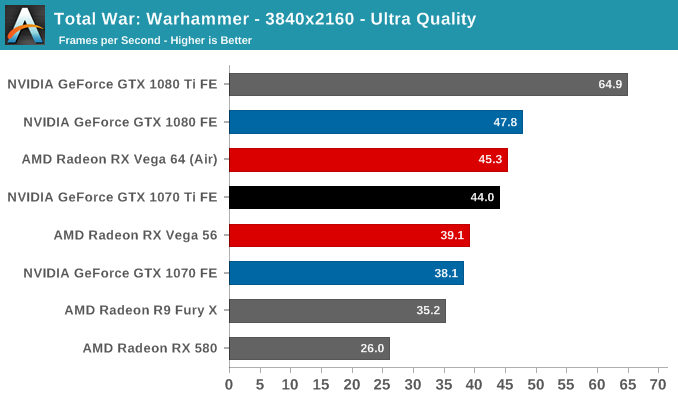
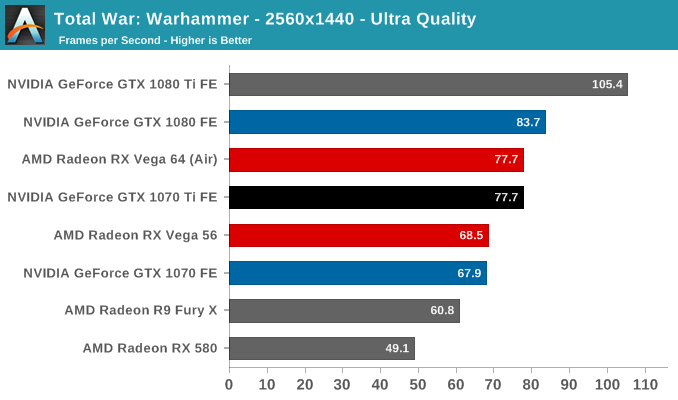
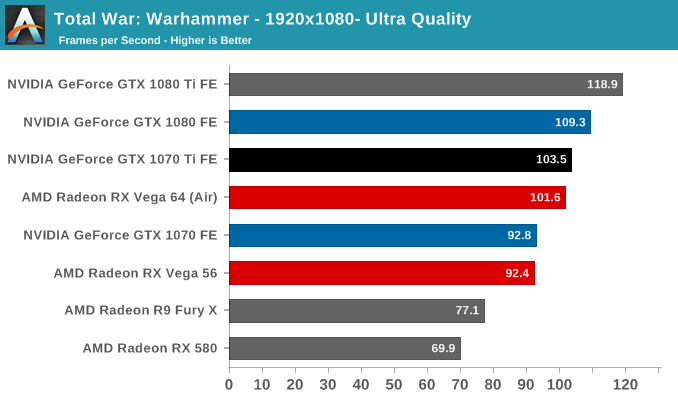
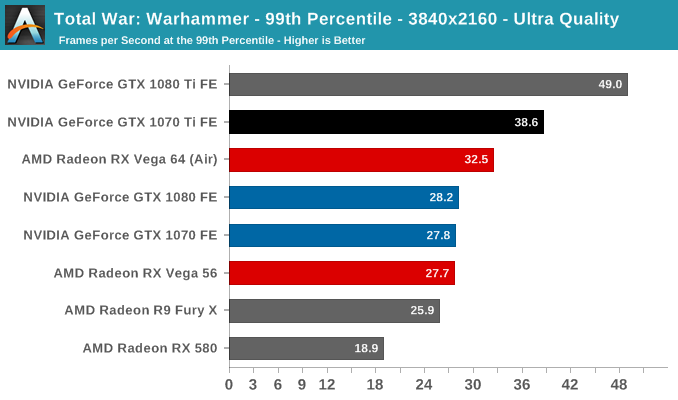
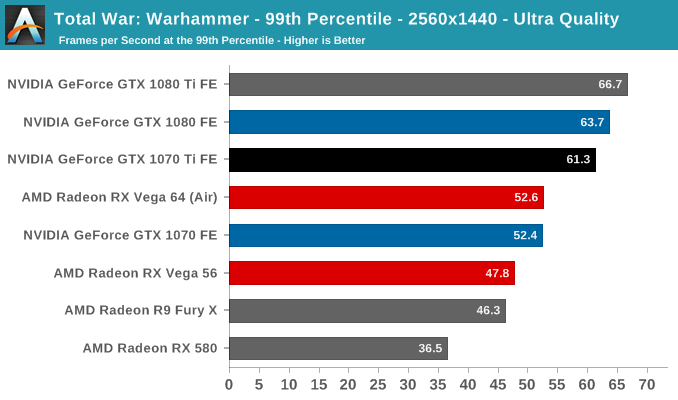
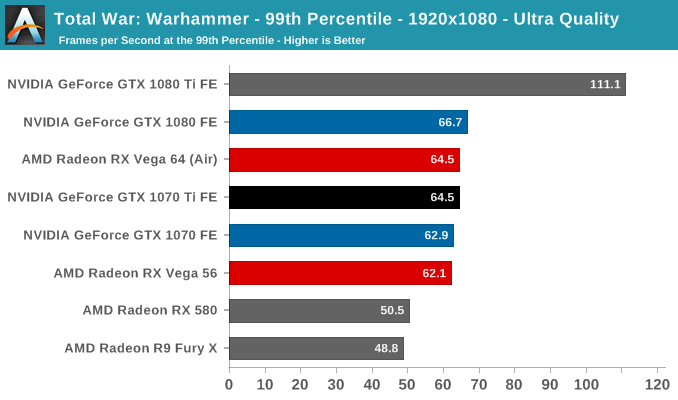
Compute
Shifting gears, let’s take a look at compute performance on the GTX 1070 Ti.
As the GTX 1070 Ti is another GP104 SKU – and a fairly straightforward one at that – there shouldn’t be any surprises here. Relative to the GTX 1070, all of NVIDIA's performance improvements actually favor compute performance, so we should see a decent bump in performance here. However it won't change the fact that ultimately the GTX 1070 Ti will still come in below the GTX 1080, which has more SMs and a higher average clockspeed (never mind the benefits of more memory bandwidth).
Starting us off for our look at compute is Blender, the popular open source 3D modeling and rendering package. To examine Blender performance, we're running BlenchMark, a script and workload set that measures how long it takes to render a scene. BlechMark uses Blender's internal Cycles render engine, which is GPU accelerated on both NVIDIA (CUDA) and AMD (OpenCL) GPUs.
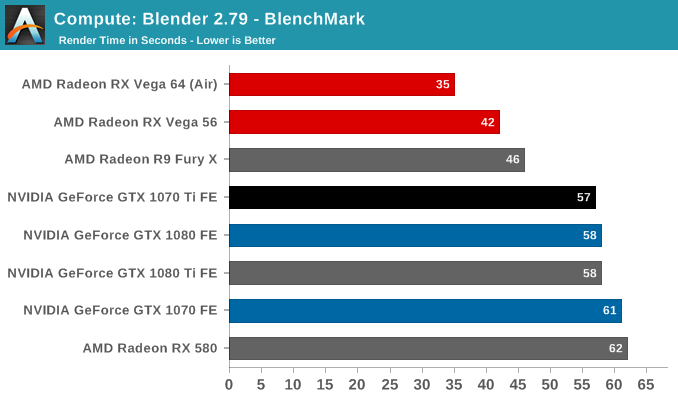
As you might expect, the GTX 1070 Ti's performance shoots ahead of the GTX 1070's due to the additional enabled SMs of this new video card SKU. In fact it technically outpaces the GTX 1080 by a single second, which although eye-popping, is within our margin of error. However what it can't do is overtake AMD's lead here, with the NVIDIA cards trailing the Vega family by quite a bit.
For our second set of compute benchmarks we have CompuBench 2.0, the latest iteration of Kishonti's GPU compute benchmark suite. CompuBench offers a wide array of different practical compute workloads, and we’ve decided to focus on level set segmentation, optical flow modeling, and N-Body physics simulations.
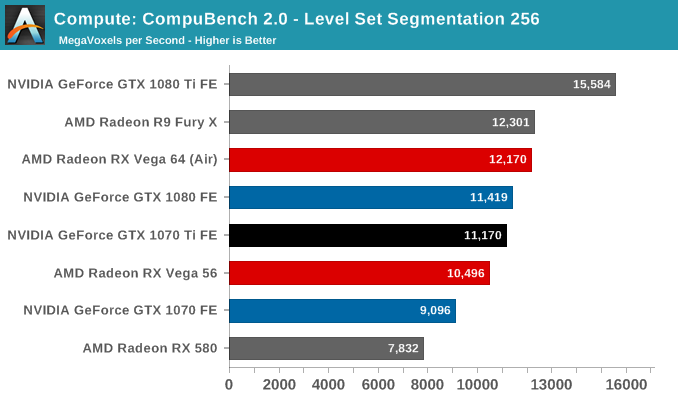
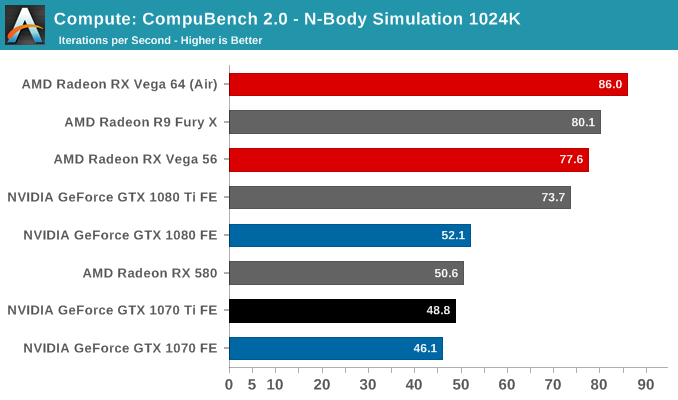
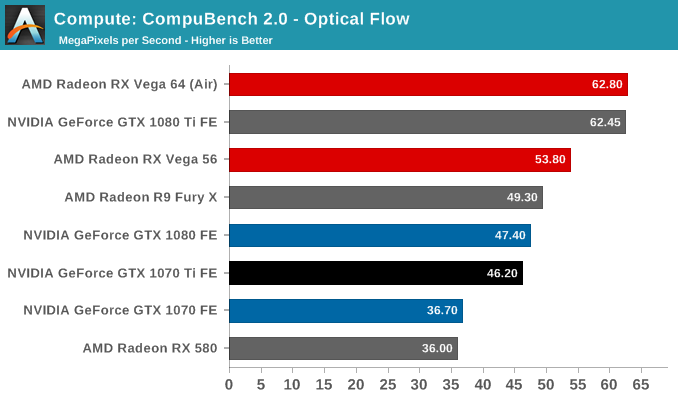
In all 3 sub-tests, the GTX 1070 Ti makes modest gains. Overall, performance is now quite close to the GTX 1080, which makes sense given the relatively small gap in on-paper compute performance between the two cards. This also means that at least in the case of these benchmarks, the lack of additional memory bandwidth isn't hurting the GTX 1070 Ti too much. However looking at the broader picture, all of the NVIDIA GP104 cards are trailing AMD's Vega family outside of the more equitable level set segmentation sub-test.
Moving on, our 3rd compute benchmark is the next generation release of FAHBench, the official Folding @ Home benchmark. Folding @ Home is the popular Stanford-backed research and distributed computing initiative that has work distributed to millions of volunteer computers over the internet, each of which is responsible for a tiny slice of a protein folding simulation. FAHBench can test both single precision and double precision floating point performance, with single precision being the most useful metric for most consumer cards due to their low double precision performance.
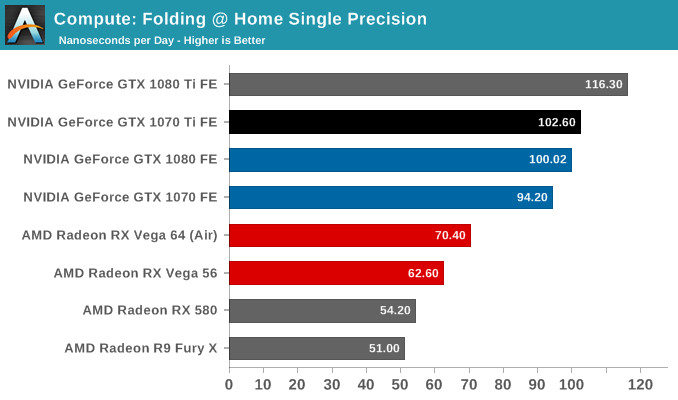
The GTX 1080 and GTX 1070 were already fairly close on this benchmark, so there's not a lot of room for the GTX 1070 Ti to stand out. Interestingly this is another case where performance actually slightly exceeds the GTX 1080 – though again within the margin of error – which further affirms just how close the compute performance of the new card is to the GTX 1080.
Our final compute benchmark is Geekbench 4's GPU compute suite. A multi-faceted test suite, Geekbench 4 runs seven different GPU sub-tests, ranging from face detection to FFTs, and then averages out their scores via their geometric mean. As a result Geekbench 4 isn't testing any one workload, but rather is an average of many different basic workloads.
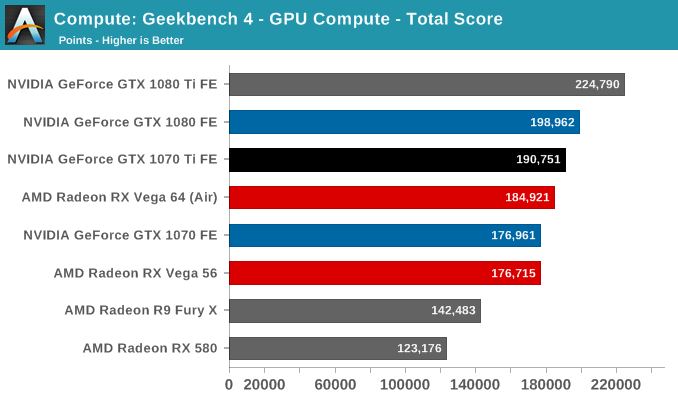
As with our other benchmarks, the GTX 1070 Ti more or less bridges the gap between the GTX 1080 and GTX 1070, falling just a few percent short of the GTX 1080 in performance. This is a test where NVIDIA was already doing better than average at, and now with its increased SM count, the GTX 1070 Ti has enough compute performance to surpass AMD's RX Vega 64, something the regular GTX 1070 could not do.
Synthetics
Continuing onto our synthetic benchmarks, we should be able to see how the GTX 1070 Ti sits in between the GTX 1080 and 1070. These tests are more graphics focused than compute focused – especially the low-level tests – so it will be interesting to see how the GTX 1070 Ti compares to its fully-featured GP104 sibling, the GTX 1080, given how close they are so often in compute tests.
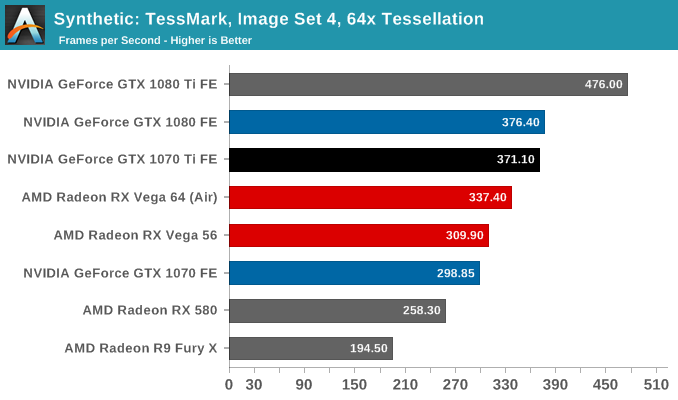
Starting off with tessellation performance, as NVIDIA's geometry performance is tied to the SMs, the GTX 1070 Ti benefits from having 3 more SMs enabled than the vanilla GTX 1070. This allows the new card to leapfrog both AMD Vega cards, coming in right behind the GTX 1080.
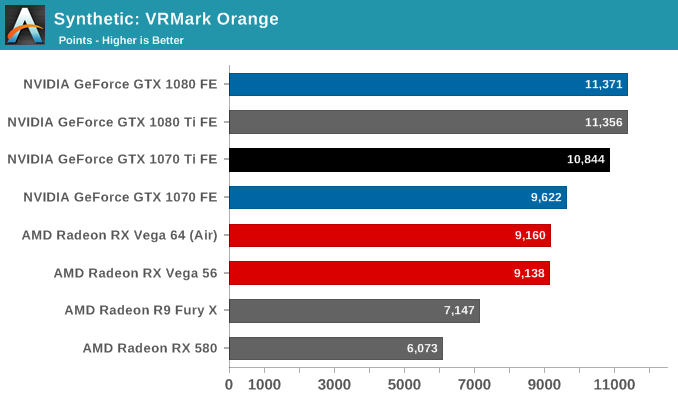
Switching gears, we have Futuremark's VRMark Orange benchmark. Essentially a synthetic gaming-type rendering workload with a focus on VR, this test pushes every part of a video card. Consequently, it also hits the weaker parts of the GTX 1070 Ti's configuration, particularly the lack of increased ROP throughput and memory bandwidth. As a result the GTX 1070 Ti still gains quite a bit over the GTX 1070, but it also trails the GTX 1080 by about 5%. Which, as it turns out, isn't too far removed from our general gaming benchmarks.
Finally, for looking at texel and pixel fillrate, we have the Beyond3D Test Suite. This test offers a slew of additional tests – many of which use behind the scenes or in our earlier architectural analysis – but for now we’ll stick to simple pixel and texel fillrates.
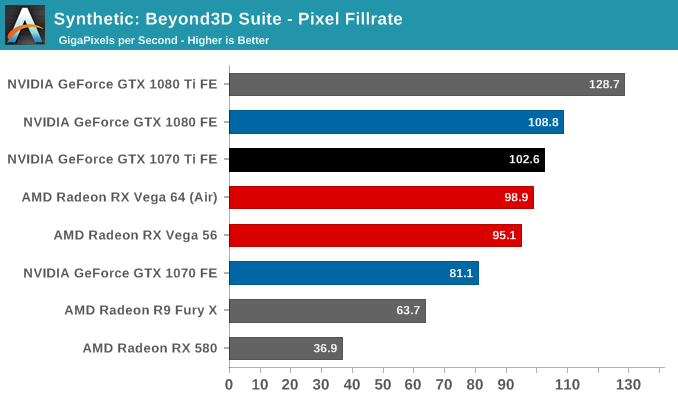
The pixel fillrate test is actually one of the more interesting results we have in today's review. While the GTX 1070 Ti doesn't get any more ROP resources on paper, pixel fillrates are a combination of both ROP (backend) and rasterizer (frontend) output. And in the case of NVIDIA's architecture, rasterization is not fully decoupled from the SMs; which is to say there's some scaling going on. And actually, this was more than I was expecting, with the GTX 1070 Ti coming very close to the GTX 1080 despite the memory bandwidth disadvantage. Not unlike tessellation performance, we see the new card leapfrog both AMD Vega cards here, pushing over 100 Gigapixels per second. In general pixel throughput is still going to be what best differentiates the GTX 1080 from the GTX 1070 Ti, but in this low-level test the two are closer than I would have expected.
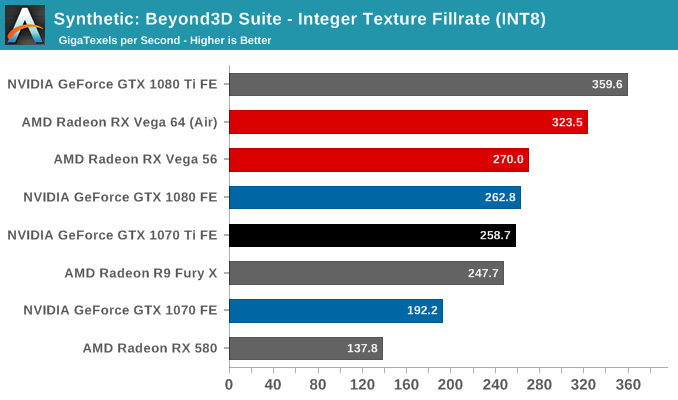
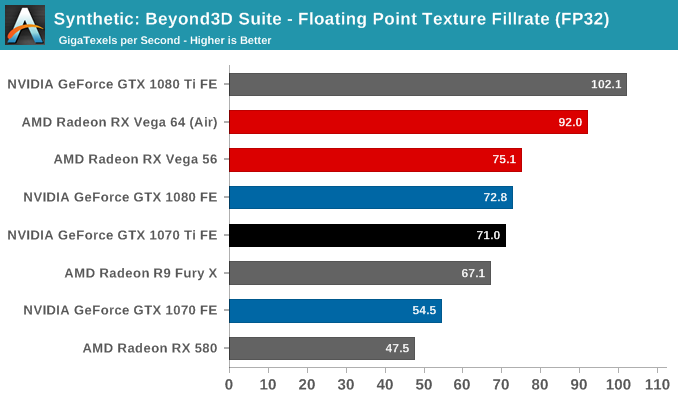
Finally, for texture throughput, we're once again looking at a scenario tightly-coupled with the SM count. As a result the GTX 1070 Ti can deliver texture throughput rates very close to the GTX 1080.
Power, Temperature, & Noise
As always, we'll take a look at inter-related metrics of power, temperature and noise. Particularly with noise, these factors can render unwanted even a decently-performing card, a situation that usually goes hand-in-hand with high power consumption and heat output. As this is a new GPU, we will quickly review the GeForce GTX 1070 Ti's stock voltages as well.
| GeForce Video Card Voltages | |||||
| GTX 1070 Ti Boost | GTX 1070 Boost | GTX 1070 Ti Idle | GTX 1070 Idle | ||
| 1.062v | 1.062v | 0.65v | 0.625v | ||
With the exception of a slightly higher idle voltage, everything remains the same in comparison to the GTX 1080 and 1070. The idle voltage actually matches the GTX 1080 Ti idle voltage, but isn't particularly significant as it seems to vary from card to card. In comparison to previous generations, these voltages are exceptionally lower because of the FinFET process used, something we went over in detail in our GTX 1080 and 1070 Founders Edition review. As we said then, the 16nm FinFET process requires said low voltages as opposed to previous planar nodes, so this can be limiting in scenarios where a lot of power and voltage are needed, i.e. high clockspeeds and overclocking.
Fortunately for NVIDIA, GP104 has always been able to clock exceptionally high, at least the good chips, so with a slight knock on efficiency in the form of a 180W TDP, the GTX 1070 Ti Founders Edition is also able to clock exceptionally high, and then a little more. I also suspect the maturity of TSMC's 16nm FinFET process is playing a part here, but the card's higher TDP and NVIDIA's clockspeed choices make it hard to validate that point.
| GeForce Video Card Average Clockspeeds | |||
| Game | GTX 1070 Ti | GTX 1070 | |
| Max Boost Clock |
1898MHz
|
1898MHz
|
|
| Battlefield 1 |
1826MHz
|
1797MHz
|
|
| Ashes: Escalation |
1838MHz
|
1796MHz
|
|
| DOOM |
1856MHz
|
1780MHz
|
|
| Ghost Recon Wildlands |
1840MHz
|
1807MHz
|
|
| Dawn of War III |
1848MHz
|
1807MHz
|
|
| Deus Ex: Mankind Divided |
1860MHz
|
1803MHz
|
|
| Grand Theft Auto V |
1865MHz
|
1839MHz
|
|
| F1 2016 |
1840MHz
|
1825MHz
|
|
| Total War: Warhammer |
1832MHz
|
1785MHz
|
|
The end result is that the GTX 1070 Ti is amusingly able to reverse the GeForce Founders Edition trend of decreased clocks with higher-performing models; that is, as we reviewed them, the GTX 1080 Ti maintained lower clockspeeds than the GTX 1080, which in turn had lower average clockspeeds than the vapor-chamberless GTX 1070, which had lower clockspeeds than the GTX 1060. Typically, that was the case due to extra hardware units, and thus extra power consumption and heat. But as we see in the GTX 1070 Ti Founders Edition, despite the extra SMs and such, the vapor chamber and higher TDP work well in allowing the GTX 1070 Ti to boost high. In fact, higher than the GTX 1070 FE across the board, but in relative terms the clockspeeds only come out to about 2% faster on average than the GTX 1070 FE. In relation to the 1683MHz boost specification, the GTX 1070 Ti on average clocks nearly 10% above that in these games, though that is something we've already seen with previous Pascal cards. And we can also start to see the line of thinking that leads to framing the GTX 1070 Ti as an "overclocking monster."
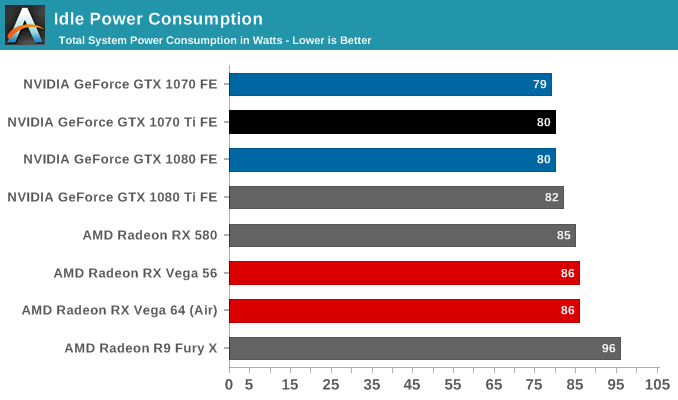
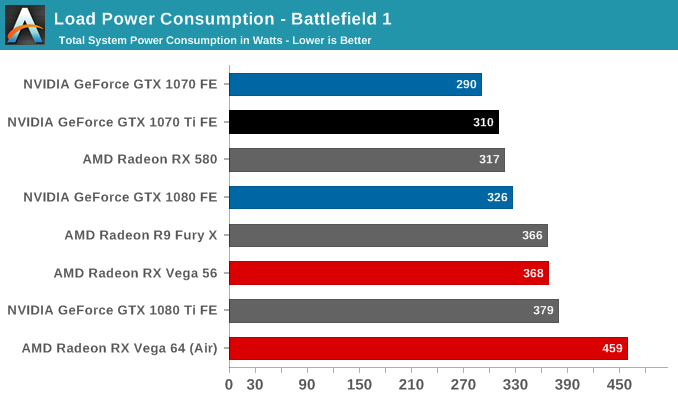
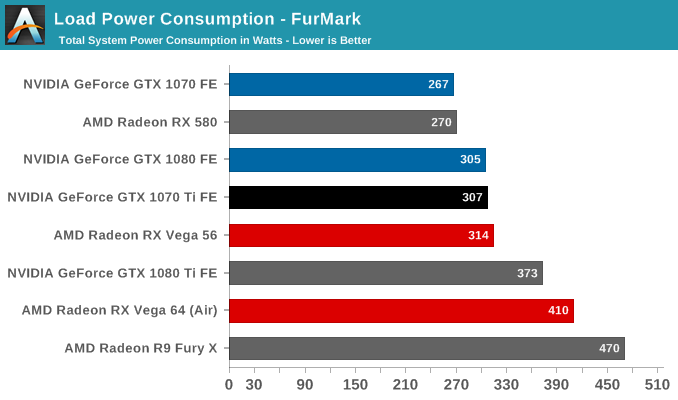
As those higher clockspeeds bear out in power, heat, and noise, there are no surprises here with the GTX 1070 Ti Founders Edition. We've already seen several variations in the aforementioned Founders Edition cards. Here, the blower and vapor chamber are more than adequate for what the card can put out, and in turn lessening the work (and noise) the fan needs to do.
Given the higher 180W TDP, the card can also be closer to GTX 1080 levels of power consumption if need be, though with measurements at the wall, the accuracy of quantification is less than ideal. But in any case, the GTX 1070 Ti has no real necessity to be a power-sipper at this performance range, for which the crown has already gone to the GTX 1070. On top of that, drops in power efficiency will likely not be noticable when compared to its RX Vega competition, or even just against RX Vega 56, whose Battlefield 1 power consumption at the wall is closer to the GTX 1080 Ti FE than the GTX 1080, let alone the GTX 1070 Ti FE.
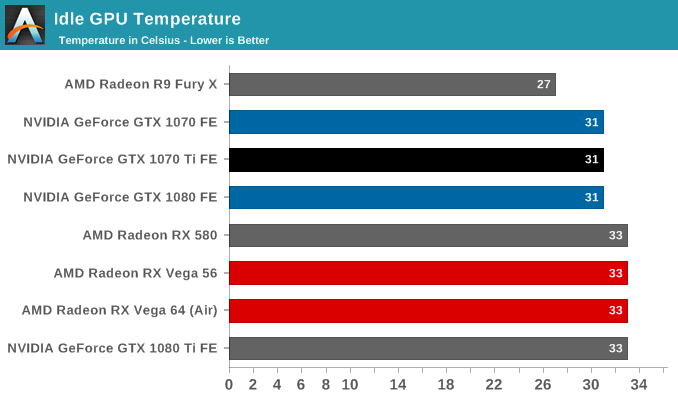
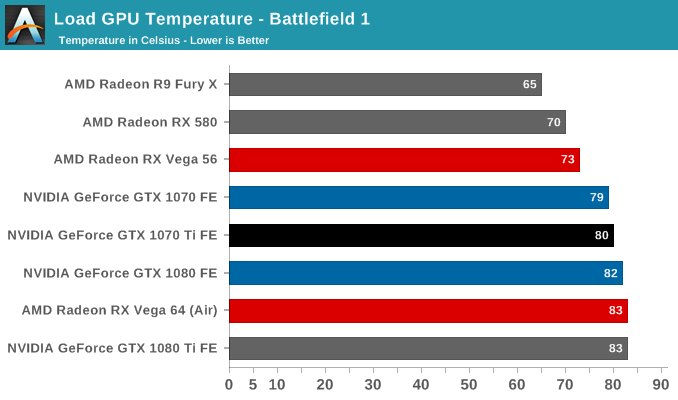
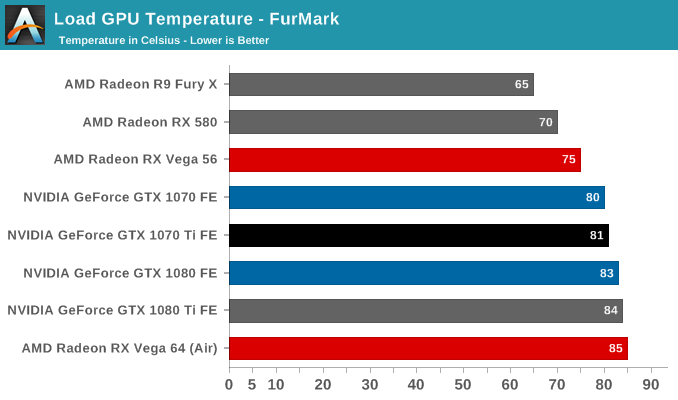
As far as heat and noise go, the GTX 1070 Ti FE has the same 83C throttle point as the GTX 1080 and 1070 FEs, and will approach there under load, though with the GTX 1080's vapor chamber cooler, is kept a little cooler. This follows in fanspeeds and noise as well, and particularly in the eternal power-virus that is Furmark. So for both temperature and noise, the GTX 1070 Ti FE sits right in between the GTX 1080 and 1070 FEs.
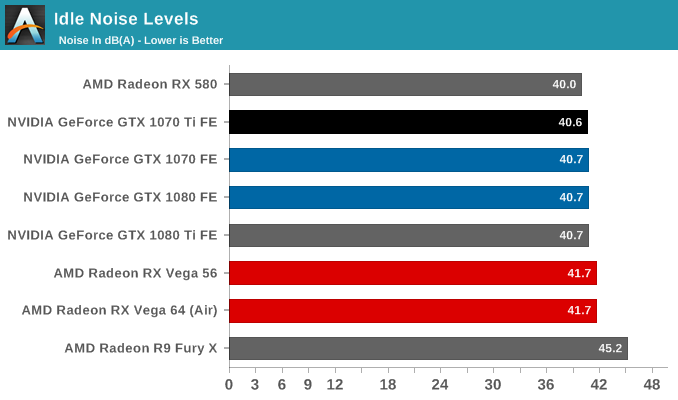
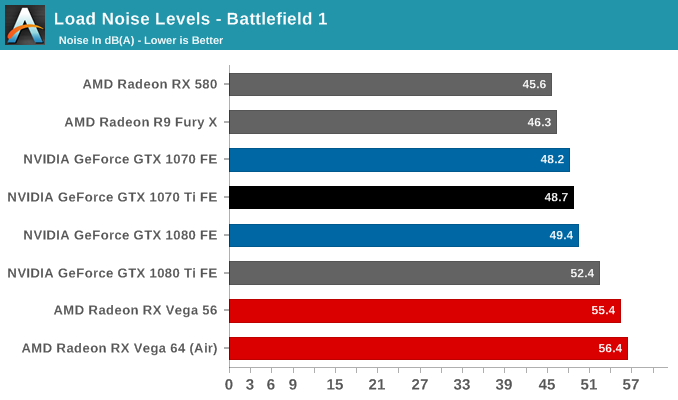
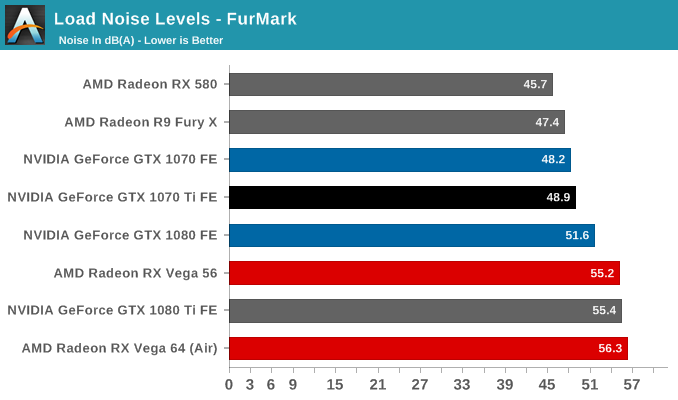
Overclocking
As NVIDIA is pushing the GTX 1070 Ti for overclocking, it is only fair that we look into it. While NVIDIA does support overclocking, they have limited actual overvolting, and instead providing the ability to unlock 1-2 more boost bins and associated voltages. Using Precision XOC, we adjusted the core and memory clocks, as well as the power/temperature limit and percent 'overvoltage.' For the 180W GTX 1070 Ti, the TDP and TDP limit match the GTX 1080, resulting in a 120% power limit (216W). The 1.093v boost voltage is no surprise, matching the GTX 1080 and 1070 FEs.
| GTX 1070 Ti FE Overclocking | ||||
| Stock | Overclocked | |||
| Core Clock | 1607MHz | 1787MHz | ||
| Boost Clock | 1683MHz | 1863MHz | ||
| Max Boost Clock | 1898MHz | 2078MHz | ||
| Memory Clock | 8Gbps | 8.8Gbps | ||
| Max Voltage | 1.062v | 1.093v | ||
The results, of course, cannot be taken as representative of all GTX 1070 Ti Founders Editions, as this is only a sampled sample size of one. But results here can offer some insight. For one, if there were explicit actual overvolting, it seems very possible to stabilize ~2100+MHz clocks on the GTX 1070 Ti Founders Edition. At any rate, GPU overclocks topped out with observed clocks in the high 2000MHz region, roughly 10% over the previously measured average in-game clockspeeds. Memory overclocks were only able to go up 200MHz from the base 2002MHz, or also about 10%. All-in-all, very similar to the GTX 1070 FE, which also managed 10% overclocks on both GPU and GDDR5 memory. Recalling that the GTX 1070 Ti FE clocked on average just 2% higher than the GTX 1070 FE at stock, there's nothing particularly groundbreaking here, especially considering the 20-25% overclock capability of Maxwell 2 reference cards.
A total of four different overclocks were tested. First was a baseline, consisting of 100% overvoltage and max power/temperature limits. The second was overclocking the GDDR5 memory by 800Mbps. The third was overclocking the GPU with a +180MHz offset; in practice this resulted in observed clocks between 2030 - 2080MHz. Lastly, all previous adjustments were combined for an overall overclock.
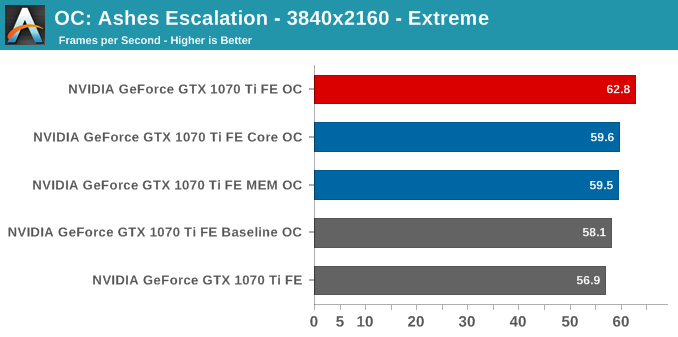
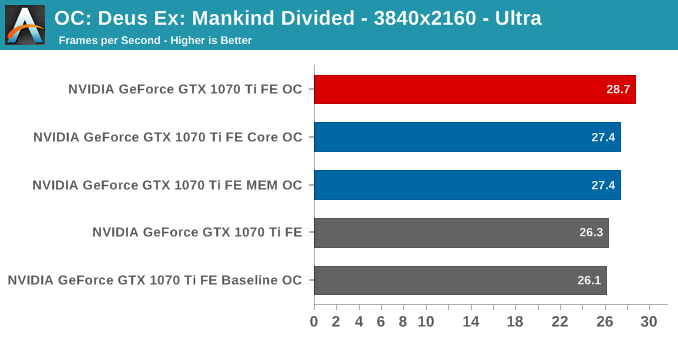
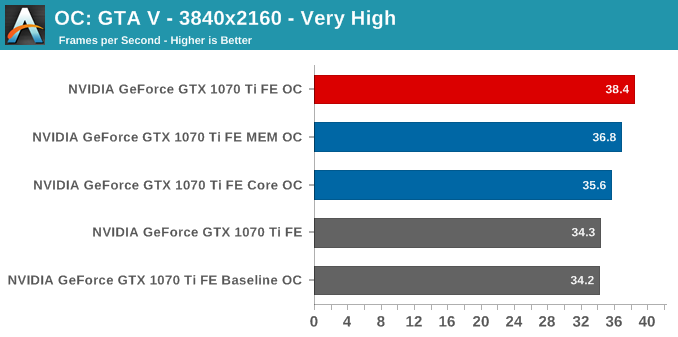
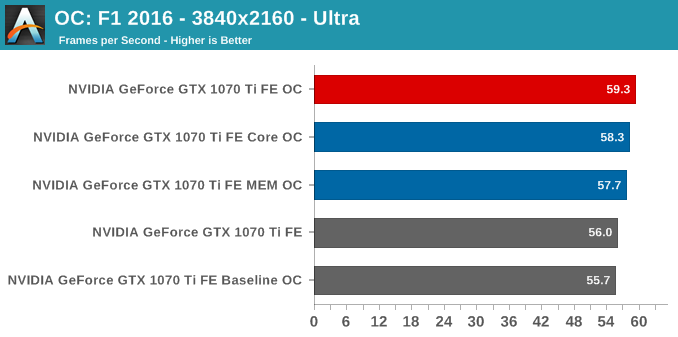
Although this is more of a cursory look than anything else, the combined overclock provides the best performance, just like it was for the GTX 1080 and 1070, although it seems like memory overclocking is more effective on the GTX 1070 Ti. Earlier, we mentioned how the GTX 1070 Ti compared to the GTX 1070 by having four more SMs but without any additional memory bandwidth, and perhaps that is playing a role here.
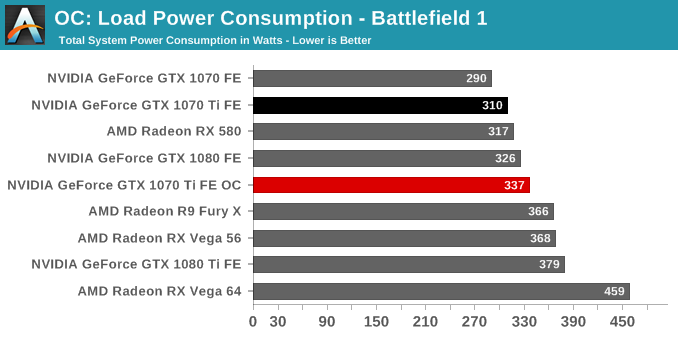
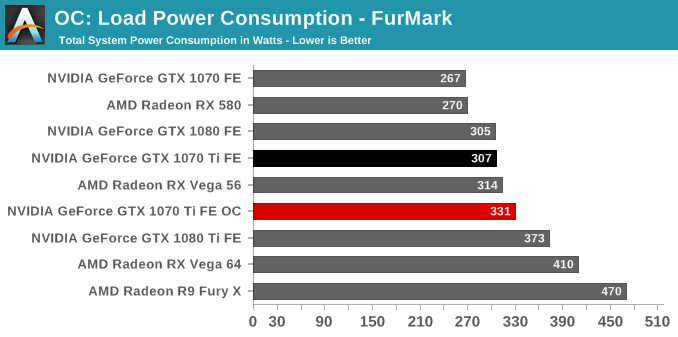
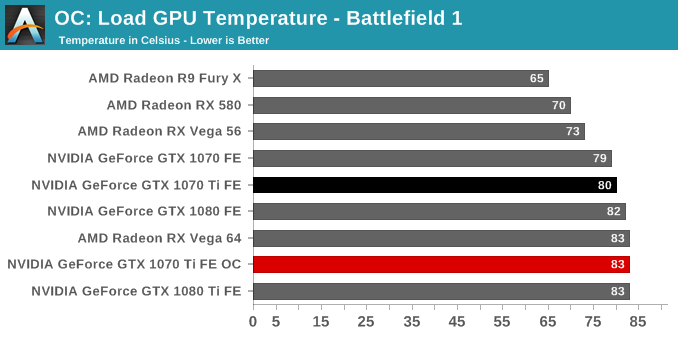
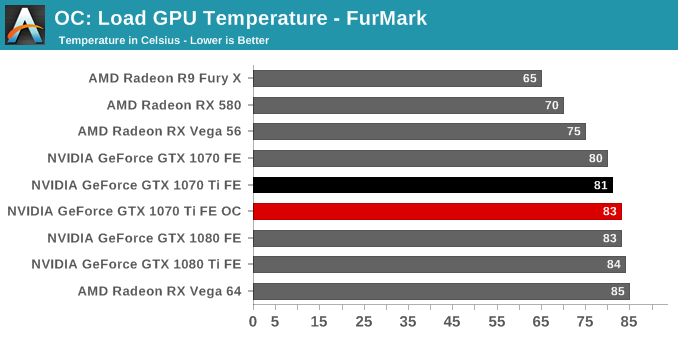
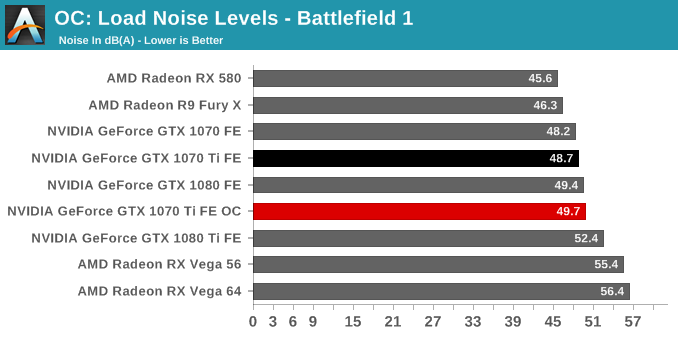
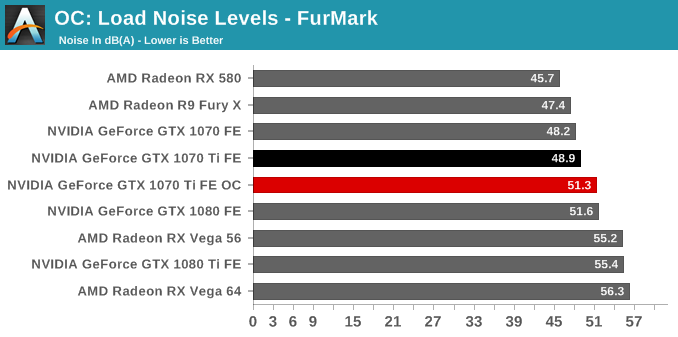
There isn't much to add on the power, temperature, and noise front. Understandably, the card will heat up a few more degrees and spin its blower faster, at the expense of ~25W at the wall, inasmuch as the 120% power limit will let it. As a casual overclocker, there may not be a lot to gain here; the GTX 1070 Ti FE already boosts to ~1800+MHz at stock, and squeezing 200MHz more with the anemic capabilities of NVIDIA's reference PCB won't make waves. And for hardcore overclockers, there would be little need of the reference board's power delivery system.
Final Words
Bringing this review to a close, for better or worse, I think this is a launch that pulls no punches and offers no surprises. While AMD's Radeon RX Vega launch was not as impactful as many of us were hoping, it nonetheless had an impact. And that impact was against the GeForce GTX 1070, where the RX Vega 56 was fast enough to give AMD an edge on price/performance; at least when the card could be found in stock for near-MSRP prices.
Given that the RX Vega 56 placed between the GeForce GTX 1080 and GTX 1070, it was really up to NVIDIA as to if they wanted to respond, and to how. A third card in the enthusiast product stack is the straightforward solution to that problem, as it allows NVIDIA to reinforce their video card lineup against whatever foothold AMD can take. NVIDIA is playing a numbers game here – one that puts their new card just $50 below the GTX 1080 – but it's a careful calculus all the same. This is what a competitive market looks like: a little messier for sure, but also one where there are actions and reactions that give consumers more and better options.
Looking back at NVIDIA’s numbers, they seem more-or-less accurate. Based on the testing done for this review, our numbers have the GTX 1070 Ti around 13% faster than the GTX 1070, and about 8% slower than the GTX 1080. But this doesn’t support or reject the idea that the GTX 1080-1070 performance gap is capable of sustaining a new model there.
Comparing the GTX 1070 Ti head-to-head with AMD's Radeon RX Vega 56 is a little trickier, depending on the games. Generally speaking, the GTX 1070 Ti Founders Edition looks to be on the order of 5% faster than the reference RX Vega 56. The main question then returns to a matter of pricing. Just last week ahead of the GTX 1070 Ti announcement, the RX Vega 64 and RX Vega 56 were selling for $569 and $469 respectively. Since then, they've dropped by $50-$70, with retail prices running around $509 and $399 respectively, almost spot-on MSRP (if at last). Meanwhile as AMD's card prices continue to fluctuate, the new GTX 1070 Ti cards will have to remain within their $449 to $500 range, bounded by the $509 GTX 1080 and the $409 1070.
When graphics card prices change frequently, as they are now, numerous cards will drop in and out of the $250 - $550 area. Recommending the GTX 1070 Ti necessarily pigeonholes consumers to the $449 - $500 price bracket, which seems unwise when they still have the options of looking at cheaper GTX 1080 models, heavily overbuilt GTX 1070s, or even reference RX Vega 56s, all of which have been oscillating in price freely over the past couple of months. In real-world terms, as discussed earlier, today that might be the MSI GTX 1080 Armor 8G and EVGA GTX 1070 FTW Hybrid, both at the same price as a $499 GTX 1070 Ti. Or to put things another way, just last week the GeForce GTX 1070 Ti was poised to be RX Vega 56's direct competitor; this week its more of of a tantalizing spoiler for those who can reach a bit deeper into their wallets.
When it comes to comparing the GTX 1070 Ti to the RX Vega 56, it's ultimately a question of how competitive NVIDIA wishes to be and how quickly they want to react. If NVIDIA needs to completely cut-off the RX Vega 56, they can lower prices, otherwise if they just want to force AMD & vendors to bring their own prices back down to MSRP, then that job has just been done. Otherwise, looking briefly at the RX Vega 64 comparison, as you might expect from how it compares to the GTX 1080, the GTX 1070 Ti doesn't quite have the performance to outdo AMD's flagship air cooled card, leaving AMD in the lead by 5%. This means that the GTX 1070 Ti isn't the RX Vega 64's direct competitor either, however it's a potential spoiler by offering 90-95% of the gaming performance for 88% of the cost (not to mention the superior power efficiency).
Meanwhile, speaking very strictly here just within NVIDA's product stack, at today's $409/$449/$509 prices, the GTX 1070 Ti is, if only slightly, the best bargain of the three cards: it's 13% faster than the GTX 1070 for an 10% price increase, and similarly, the last 8% of the performance of the GTX 1080 comes with a 13% price premium. Otherwise all three cards are very similar, scaling in performance, price, and power consumption as you traverse the narrow $100 range. NVIDIA is pitching the GeForce GTX 1070 Ti as an upgrade for the practically legendary GTX 970, however since it launched at only $329, the GTX 970 was never this expensive. Arguably this is more of a late upgrade option for the GTX 980, but at this point I'm splitting hairs. If you are upgrading from an older NVIDIA card, you have a clear price/performance spectrum to pick from.
Otherwise, as custom GTX 1070 Ti cards hit the market over the next few weeks and settle down, it will become clearer what options they bring and how they fit into the market. Looking at our results, a factory-overclocked custom GTX 1070 Ti could easily hit GTX 1080 levels, but is not likely to be an option for precisely that reason.
Returning to the GTX 1070 Ti Founders Edition, it is a solid card with the GTX 1080 Founders Edition's vapor chamber cooler and reference 5+1 power phase PCB, all at a static $449 and reasonable power consumption. But ultimately it is a reference card with performance in between the GTX 1070 and GTX 1080, with a price to match. Given that GTX 1080 and 1070 models have been in that space for some time, that price point may be better some days and not on others for what you need. This isn't a card that is meant to drastically alter the enthusiast video card market in the last months of the year – which is to say that it doesn't do much to alter the balance between NVIDIA and AMD – but rather it's a card that is designed to offer a proportional option between the GTX 1080 and GTX 1070.

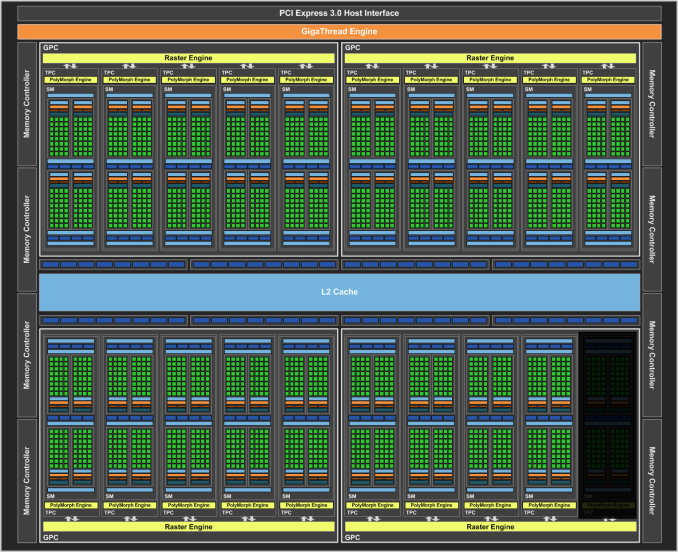
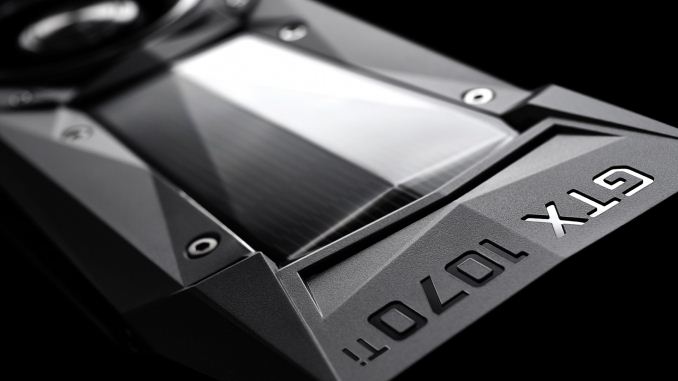
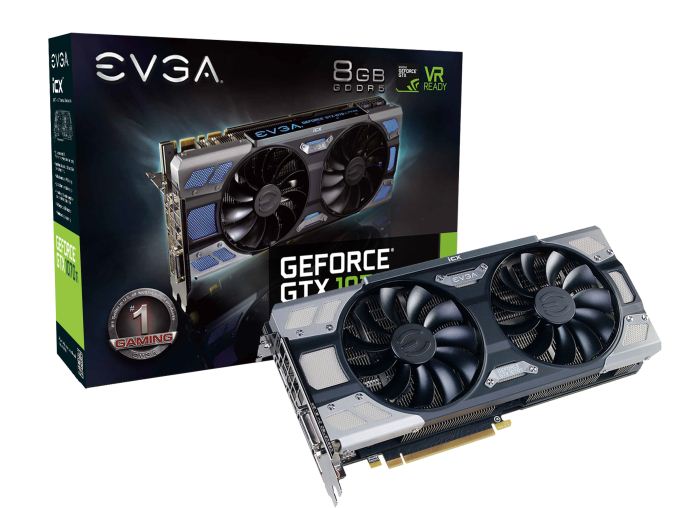
_thumb.jpg)




_thumb.jpg)
_thumb.jpg)
_thumb.jpg)




